The Kinabatangan River Basin is a dream come true for wildlife enthusiasts and adventurers seeking out the rare and elusive.
Snaking its way through the northeastern Malaysian state of Sabah on the legendary island of Borneo, the Kinabatangan River may seem like a remote wilderness at the edge of the world (that’s what we used to think).
But Lori and I found this pristine reserve to be suprisingly easy and economical to access from Sandakan, Kota Kinabalu, Kuala Lumpur, and points beyond.
Here’s our first-hand guide for travelers—including our top recommendations for Kinabatangan River tours, our lodging picks, tips from our own experience, and our honest opinion about the place.
Why Visit
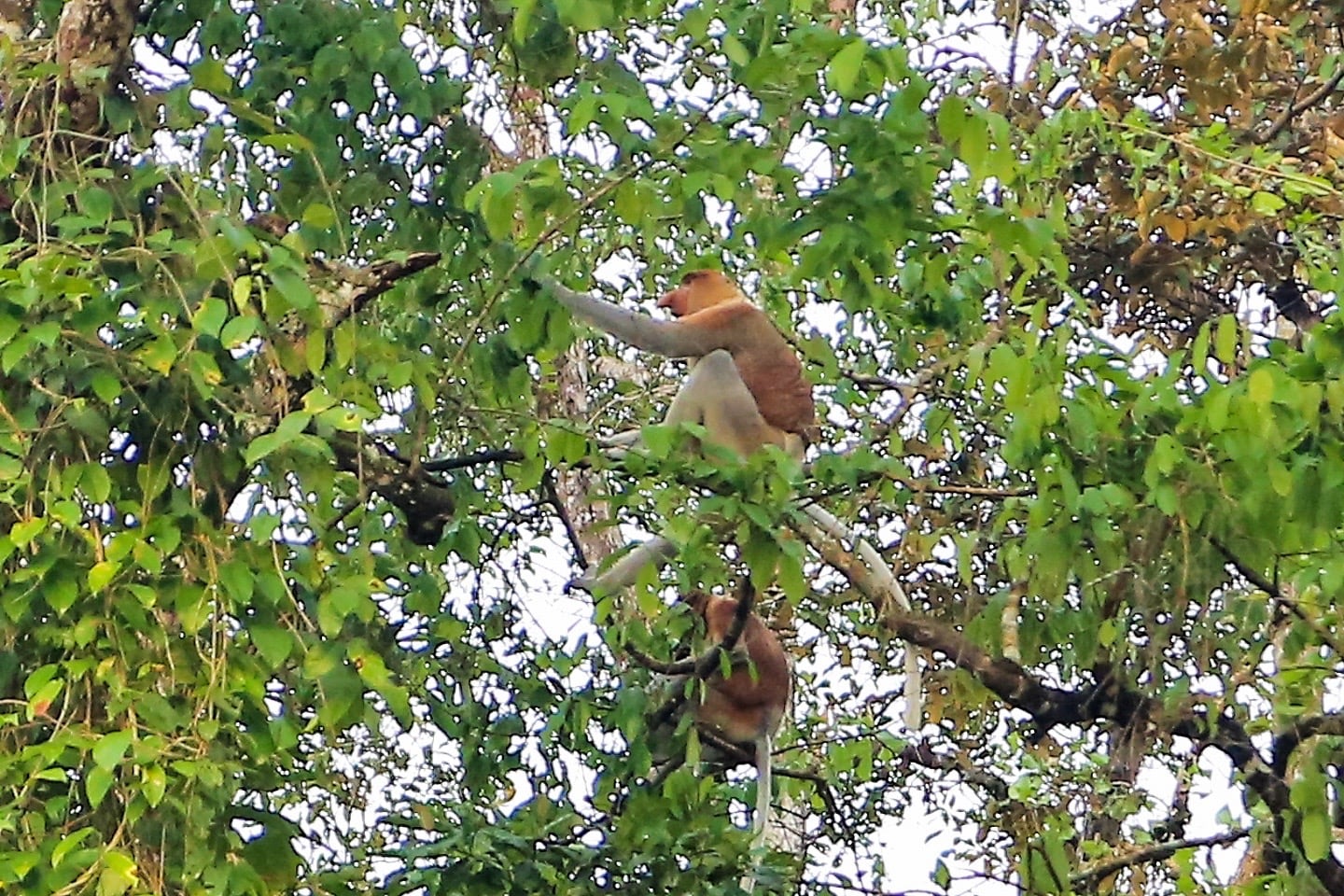
Exploring the Kinabatangan River is a one-of-a-kind, bucket list sort of experience that was one of the highlights of our time in Sabah and Malaysian Borneo. Here are our top reasons for why you might want to consider visiting:
Amazing Wildlife
The Kinabatangan River is known for its mindboggling variety of wildlife. It’s one of the very best places to catch a glimpse of Borneo’s iconic species, like the endangered pygmy elephant, orangutans, proboscis monkeys, and hornbills. We think the best way to accomplish this is on a boat tour (see our recommendations below).
World-Class Bird Watching
With over 200 species of birds, the Kinabatangan River is pretty much a birder’s dream. Keep an eye out for colorful hornbills, kingfishers, eagles, and the rare storm stork hanging out or nesting along the riverbanks.
Rich & Diverse Jungle Ecosystem
The river flows through a diverse ecosystem made up of lowland rainforest, mangrove swamps, oxbow lakes, and limestone caves. All Lori and I had to do was hop on a boat and make our way along the river with a local guide to experience the region at its best.
Spectacular Scenery
There are so many opportunities for awe-inspiring backdrops and eye-popping photos it felt a bit overwhelming at times trying to strike a balance between capturing the experience and soaking it all in.
We particularly loved how the mood of the river can change throughout the day, from early morning fog, to afternoon showers, and spectacular sunsets.
Cultural Immersion
The flora and fauna aren’t the only draws to this fascinating destination.
Getting to meet the local residents living in the communities along the Kinabatangan River taught us so much about this amazing place and helped us gain a better understanding of the way of life that’s been practiced here for generations.
Staying in eco-lodges or with local families is one of the best ways of experiencing this, first-hand.
Conservation Efforts
Your visit to the Kinabatangan can also help support conservation efforts, as many tour companies work closely with local organizations to protect the fragile environment and endangered wildlife of this unique corner of the world.
Getting There
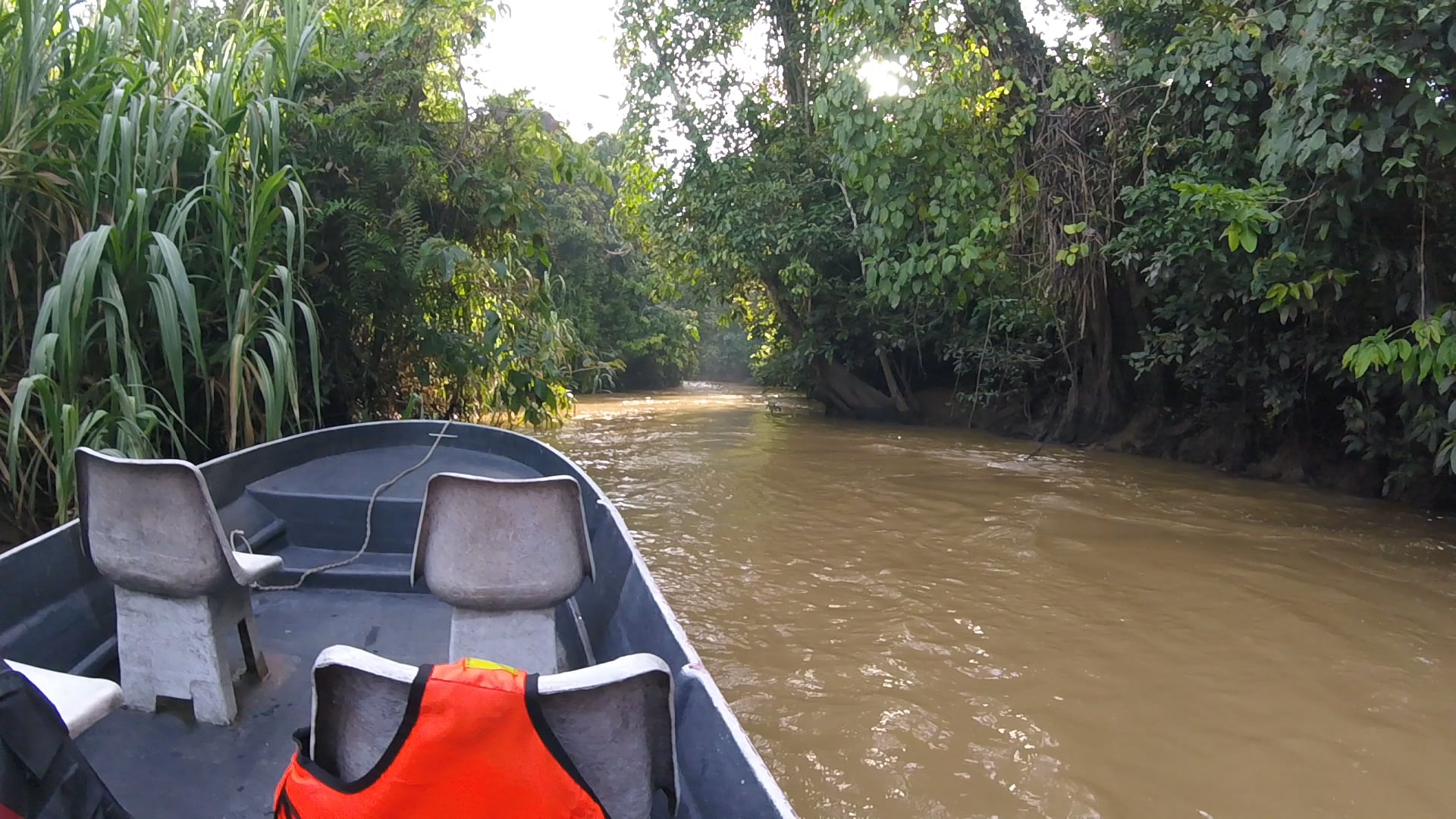
Because the Kinabatangan River is located on a huge, offshore island, there are a few more steps to getting here than other destinations in Southeast Asia. With that said, we didn’t find the journey terribly daunting or expensive.
We flew AirAsia from KLIA2 in Kuala Lumpur to Kota Kinabalu (BKI). We might have considered a bus or taxi to cover the six hours by land between Kota Kinabalu and Sandakan (the nearest major town to Kinabatangan), if internal flights weren’t so reasonable.
Because we visited Kudat first, we opted for a short flight from Kudat to Sandakan on MASWings, then a return flight on AirAsia between Sandakan and Kota Kinabalu.
In general, here’s the breakdown of getting to Kinabatangan:
Fly to Sabah, Borneo
- Nearest Airport Kota Kinabalu International Airport (BKI) is the main entry point to Sabah, Malaysia, or Sandakan Airport (SDK), which is closer to the Kinabatangan River.
- Connecting Flights From major cities in Malaysia like Kuala Lumpur or international hubs, you can get direct flights to Kota Kinabalu or Sandakan.
Travel from Sandakan to the Kinabatangan River Basin
- By Tour Many people join tours that provide transportation directly to the Kinabatangan area. These tours often include guided river cruises, jungle treks, and accommodations.
- By Road The journey from Sandakan to Sukau (a popular entry point to the Kinabatangan River) is about 2-3 hours by car. You can book a private car, shared van, or bus from Sandakan.
- By Boat We’d heard that some eco-lodges offer boat transfers from Sandakan (giving a scenic introduction to the area), but we weren’t able to work this into our itinerary.
Tips for Your Visit
- Pack for Humidity The rainforest climate here means it’s hot and humid. Lightweight, moisture-wicking clothes are ideal.
- Bring Mosquito Repellent Essential for the jungle in all seasons!
- Wildlife Watching The river is home to pygmy elephants, proboscis monkeys, crocodiles, and more. Early morning and late afternoon river cruises are prime times for spotting wildlife (but your guide will already know this, of course). Bring a solid pair of binoloculars!
- Alcohol Keep in mind that this is a predominately Muslim area and alcoholic beverages aren’t widely sold. If this is a deal breaker for you, we recommend visiting a mini-mart in Sandakan before arrival and consuming your beverage in a cultural mindful (and responsible) way.
Kinabatangan River Accommodation
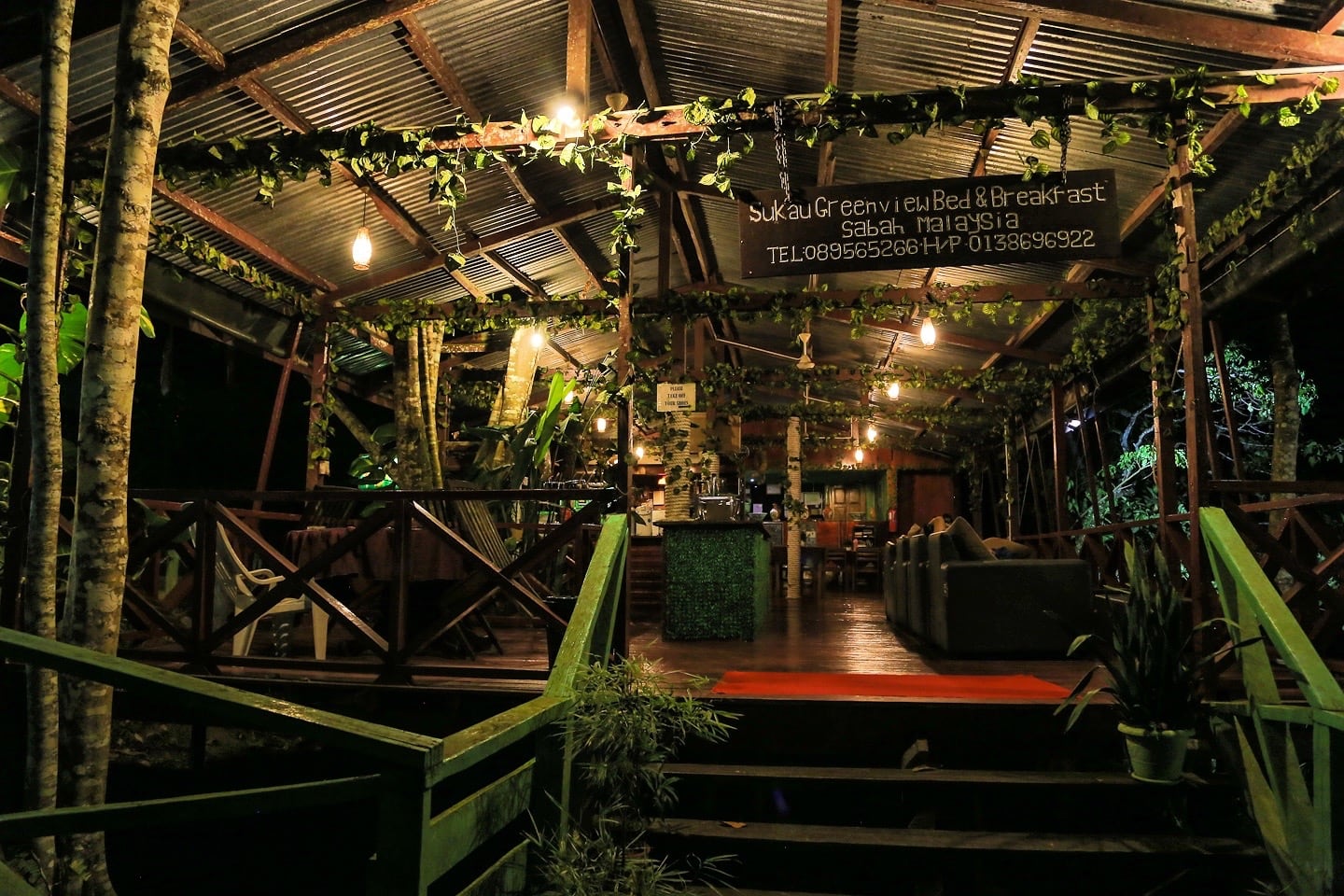
There are numerous ways to experience the Kinabatangan. If a quick day trip is what you’re after, booking a tour direct might be the easiest and most cost-effective route. If you plan to stay multiple days (which we did and highly recommend!), booking direct through one of the area’s lodges is the way to go.
Here are some of the top lodges that offer comfort, top-rated wildlife experiences, and sustainable practices:
- Bilit Rainforest Lodge: Located near the Bilit village, this eco-friendly lodge is set right on the riverbank, offering excellent access to wildlife viewing and other activities like river cruises, forest hikes, and treks to nearby caves. The lodge also has chalet-style accommodation and eco-tours led by knowledgeable guides.
- Sukau Rainforest Lodge: Sukau Rainforest Lodge is known for providing a luxurious, yet eco-conscious experience. It has won awards for sustainability and is Green Globe-certified. You can look forward to a comfortable room, a variety of guided excursions, and a private jetty for river cruises.
- Tanjung Bulat Jungle Camp: For a more rustic and personal experience, Tanjung Bulat is a locally-owned lodge that that’s located in a remote part of the river, away from the main tourist trails.
- Sukau Greenview Bed & Breakfast: A good budget to middrange option with basic accomodations and knowledgeable guides. This is where we stayed and were pleased with the amenities and experience for the price.
Keep reading for much more on our stay including a breakdown of our daily itinerary, photos, and more!
Our Kinabatangan River Experience
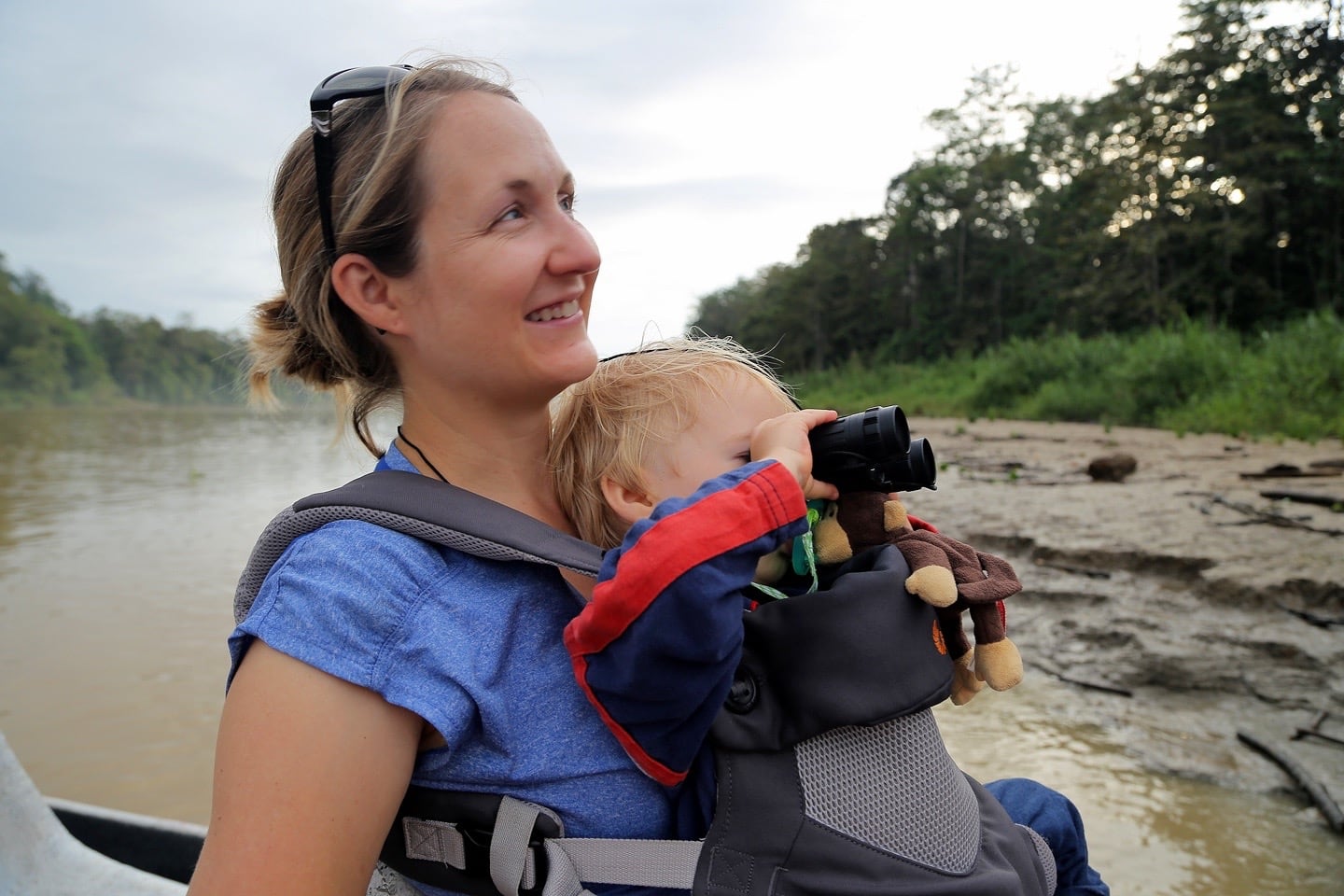
Overview
We spent three days exploring one of the most diverse habitats in the world—the Kinabatangan river basin—home to Borneo’s highest concentration of wildlife!
Here’s our detailed, day-by-day trip report, which we hope will give you a good idea of what you might expect from your own visit.
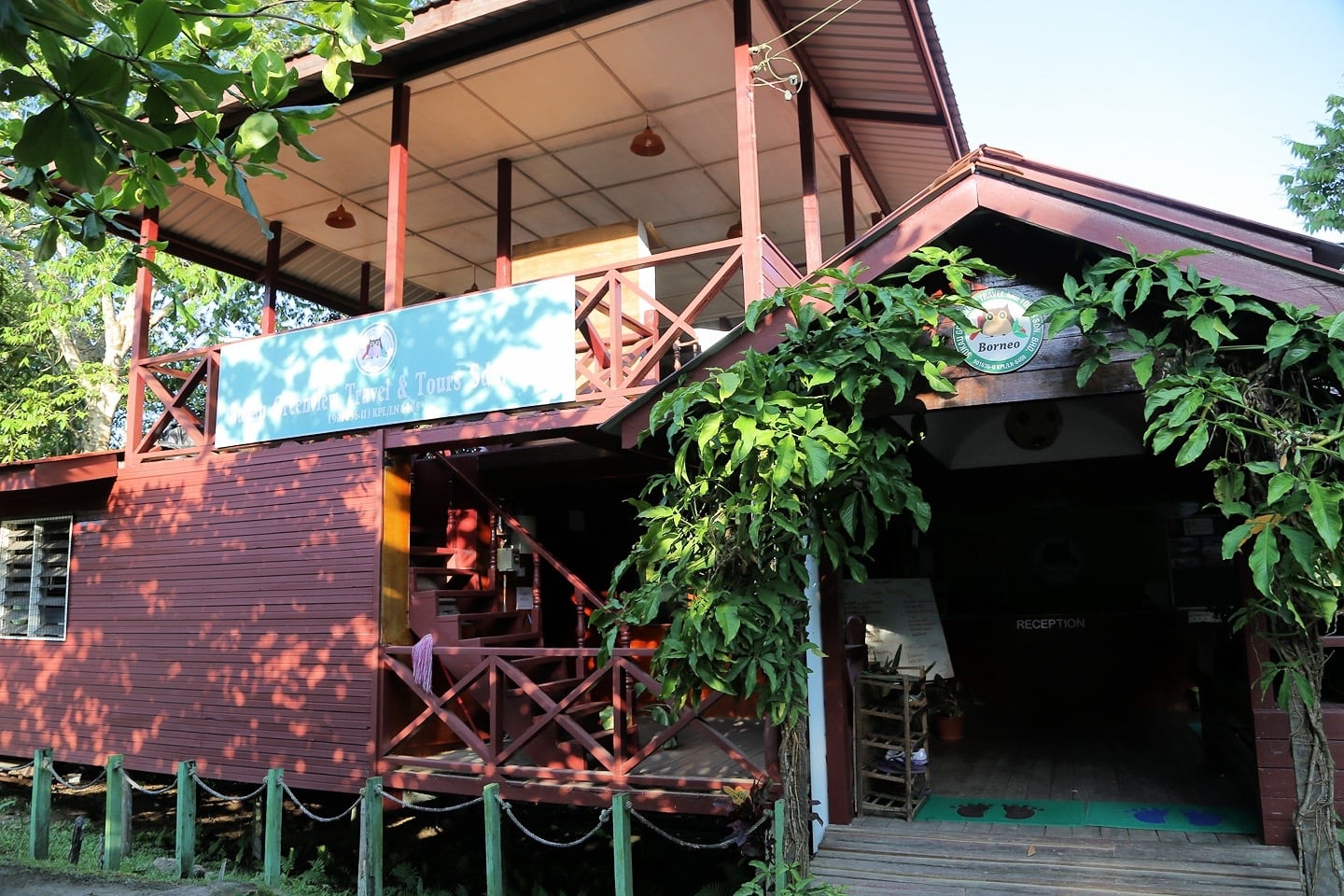
After much research, I booked us at Sukau Greenview B&B. We’re very happy with our experience with them and would highly recommend them to others for the value at this price point—and I say that because undoubtedly there are far more luxurious lodges you could book with in the area that cost much more, of course.
If you’re not looking to spend a lot of money, but want something all-inclusive with excellent guides, friendly staff, delicious and filling food, and perfectly adequate jungle lodge accommodation (clean, A/C, hot shower, bug-free) then Sukau Greenview is worth serious consideration.
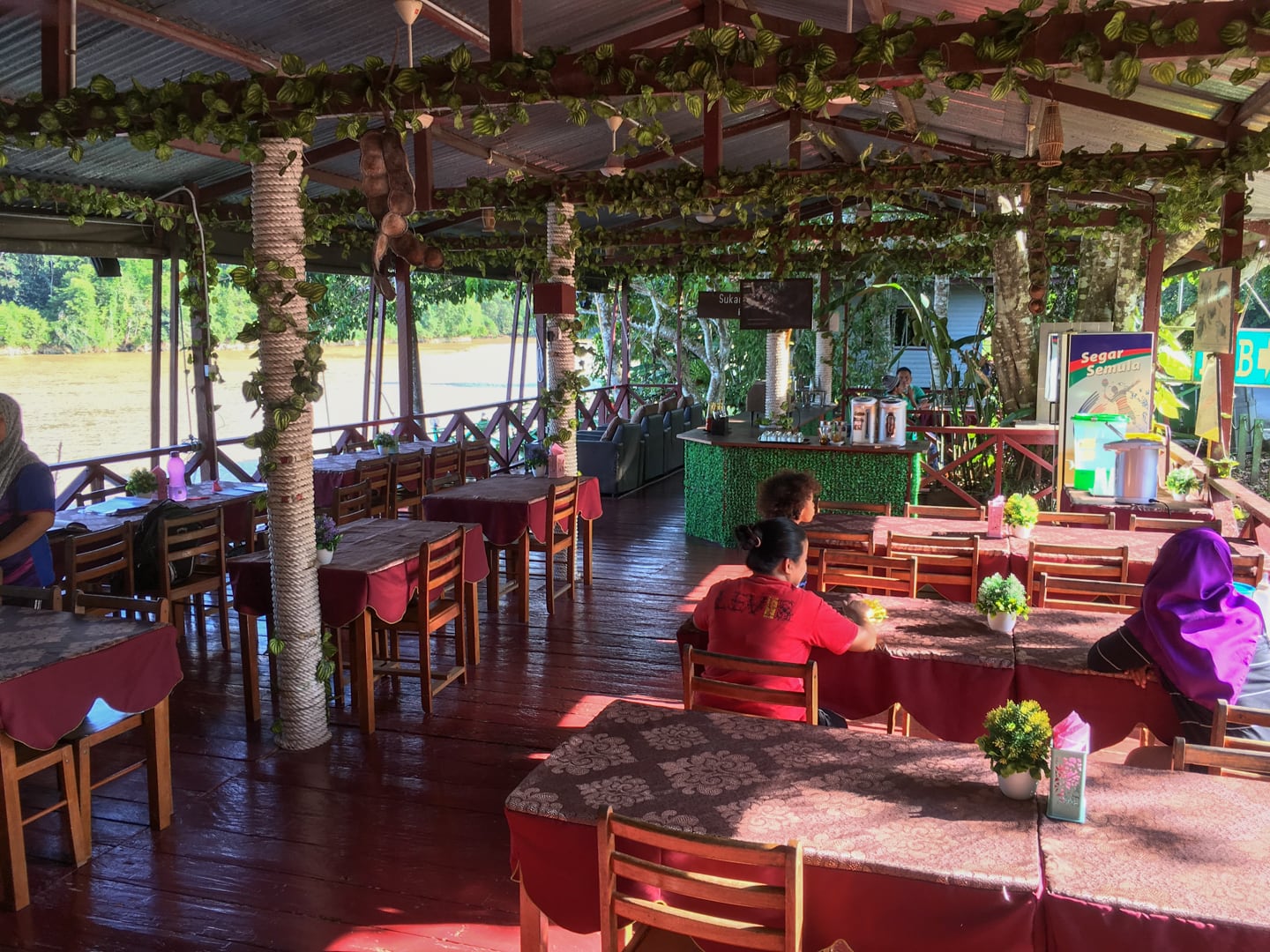
They offer a variety of different all-inclusive packages for whatever length of time you might be interested.
We had no problem putting together a custom package with them (to accommodate Noe’s nap times and factor in some much-needed rest time for all of us), so they do that too.
We were also able to move around a few things last minute due to weather and Noe, and all but one of our guided treks ended up being private (just us, the guide and the boat driver) though this fluctuates with the seasons and number of guests.
Our [modified] package itinerary:
Day One
- 08:30—Pickup from Sandakan Backpacker Hostel. Transfer to Sepilok.(Transfer from Sandakan town to Sepilok ended up being in a private taxi; transfer from Sepilok to Sukau was in a large minivan with another couple staying at Sukau Greenview).
- 09:30—Arrive Sepilok. Watch the video presentation documenting the conservation program on Orangutan rehabilitation.
- 10:00—Enjoy viewing semi-wild Orangutan at close range while they are fed by park rangers. Take in their natural habitat. (We later added on the Sun Bears Sanctuary at our own cost—we ended up with an excellent Sukau Greenview guide for the Orangutan center portion (which we didn’t know we’d have and was a pleasant surprise), but Sun Bears were on our own).
- 12:30—Lunch at Sepilok Cafeteria.
- 13:30—Shuttle to Sukau Kinabatangan for about 2 hours.
- 15:30—Arrive at Sukau Greenview Bed & Breakfast! Get a briefing of the activities during your stay with us and check-in to cabin. Relax for remaining afternoon. (We opted to stay in one of their private cabins, but rooms and dorms are also available).
- 18:30—Enjoy dinner of Sabahan special dishes on the river.
- 19:30—Night cruise dedicated for nocturnal wildlife such as kingfishers, Buffy fish owls, wild cat, snakes, frogs, and others. Watch for the flaring eyes of a crocodile while having its night swim. Drift your way back to the lodge for a good night sleep. (this night cruise was originally scheduled for the next day, but on arrival we asked to do it on the first day instead because Noe had had a good, late nap).
- 20:30—Return for a good night’s sleep.
Day Two
- 08:00—Breakfast is served.
- 09:00—Explore the jungle and see different plants and unique trees. Have a significant encounter with wildlife while breathing the smell of a virgin forest. (Unfortunately, we had to cancel the jungle trek due to weather—it poured from sun up to about noon).
- 12:30—Relax in the restaurant and enjoy your lunch.
- 16:00—Cruise the afternoon in Sabah’s longest river and one of the most biodiverse areas in the world, the Kinabatangan River. Watch wildlife abound along the banks and visit one of its famous tributaties for more wildlife.
- 18:30—Enjoy dinner of Sabahan special dishes at our riverside restaurant.
Day Three
- 06:00—Cruise among the fog and feel the cool morning breeze. Hear the songs of the birds, watch proboscis monkey, macaques, and other wildlife. Cruise your way back to the lodge.
- 08:00—Breakfast is served.
- 08:30—Load your luggage and drive back to Sandakan airport.
- 10:30—Arrive at at Sandakan airport.
Total package cost for 2 night’s lodging in private cabin, all meals, transport to/from Sandakan, guided activities (English-speaking), entry fees (Sepilok Orangutan center), and taxes was US$350. The latest rates and info on their 3D2N package can be found here.
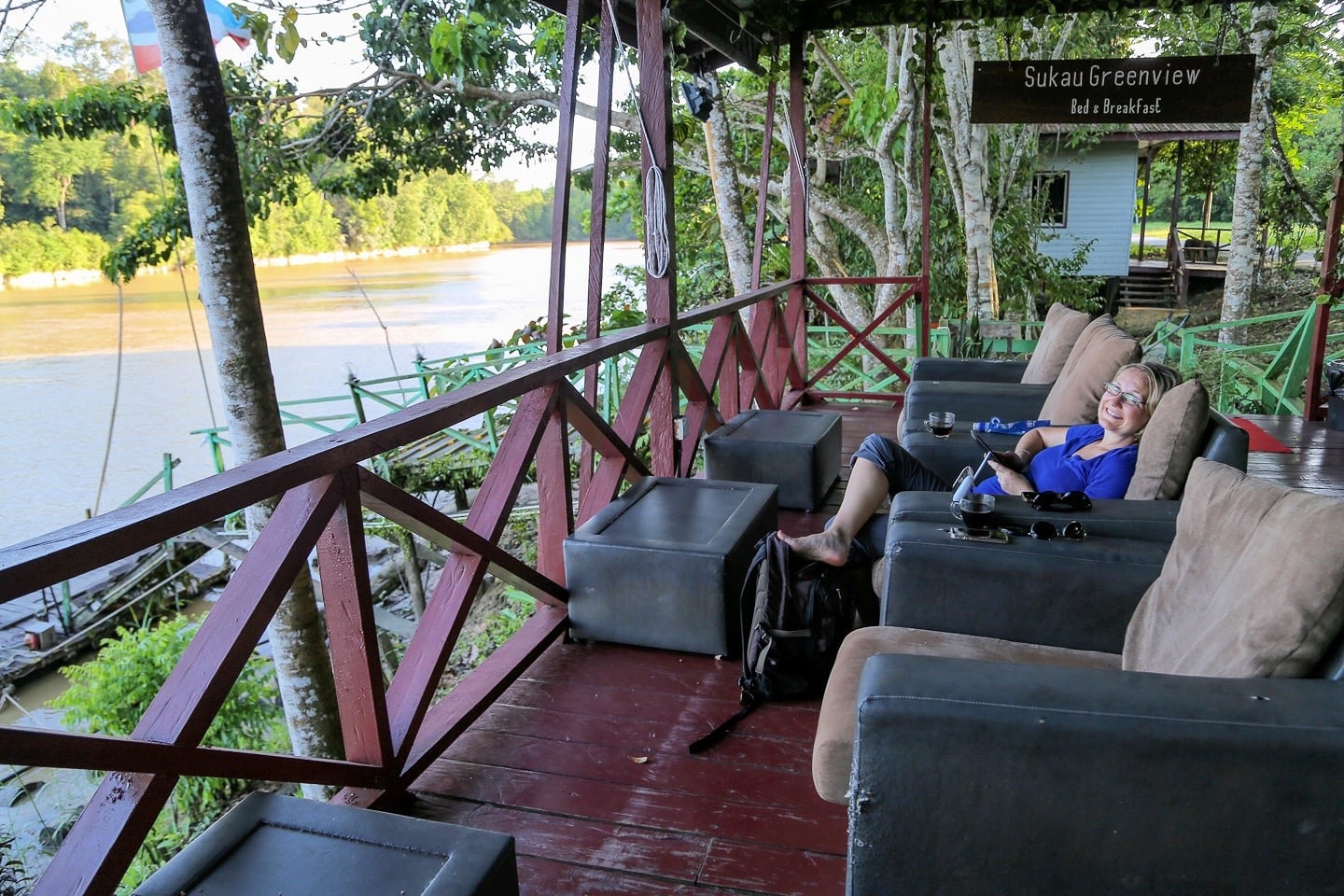
Day 1
The village of Sukau is a two-hour drive from Sepilok and is the jumping off point for exploring the Kinabatangan River wildlife sanctuaries.
We’re not sure what we’re going to see over the next few days, but chances are we’ll see some rare animals we’ve never seen before—neither in the wild nor in a zoo—so we’re excited.
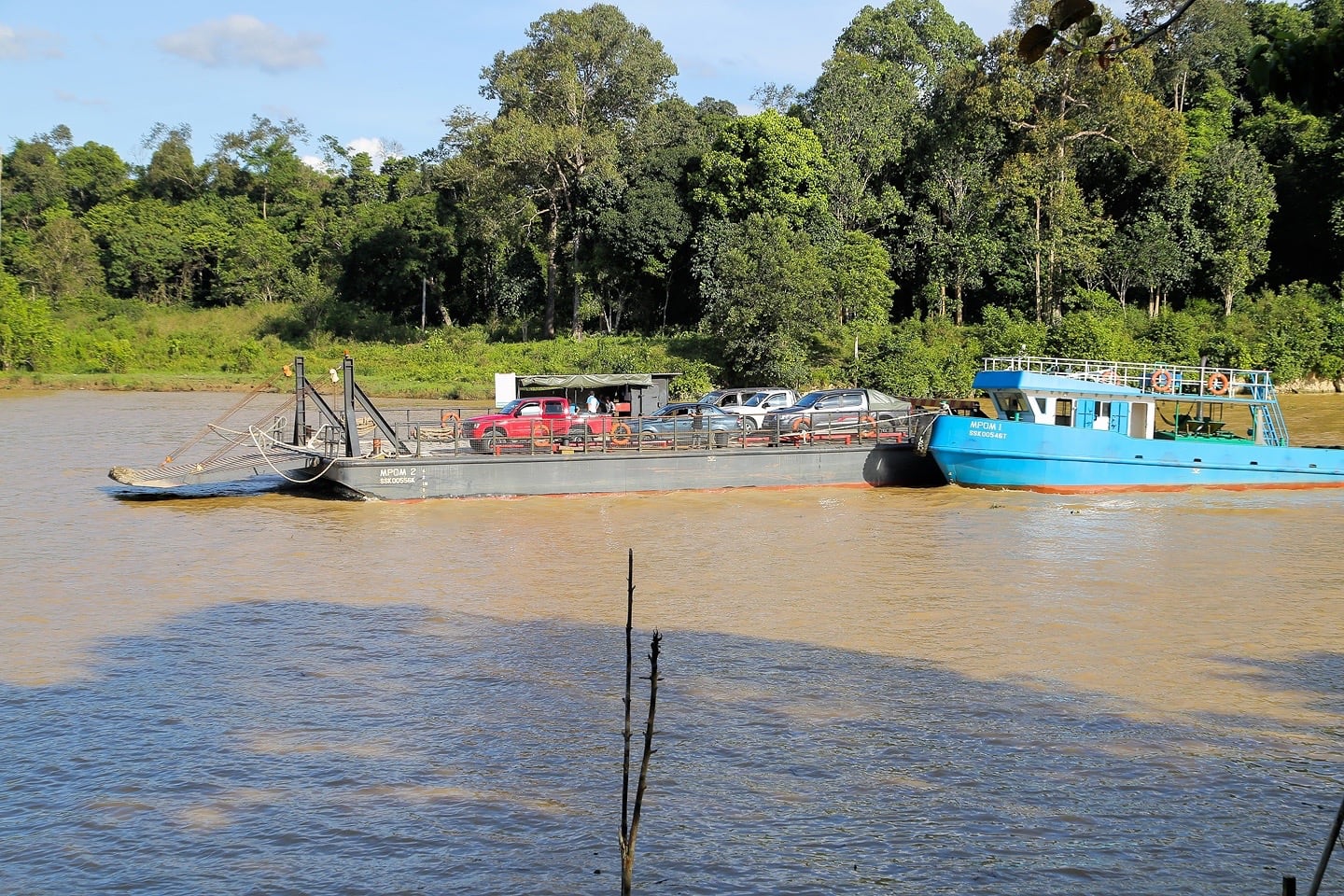
There’s a frequent car ferry (tug-pushed barge) that connects the Sukau side of the Kinabatangan River with the east bank of the river.
It runs from Sukau village to the Morisem terminus, just across the river from our lodge. We enjoyed watching it maneuver around from the lodge’s riverside restaurant (Noe thought it was the best thing ever, of course).
It wasn’t until our second day that I learned that this little river ferry (known as the Morisem ferry) had become world famous in the past couple of years, finding itself at the center of a major ecological controversy, but we’ll get to that later.
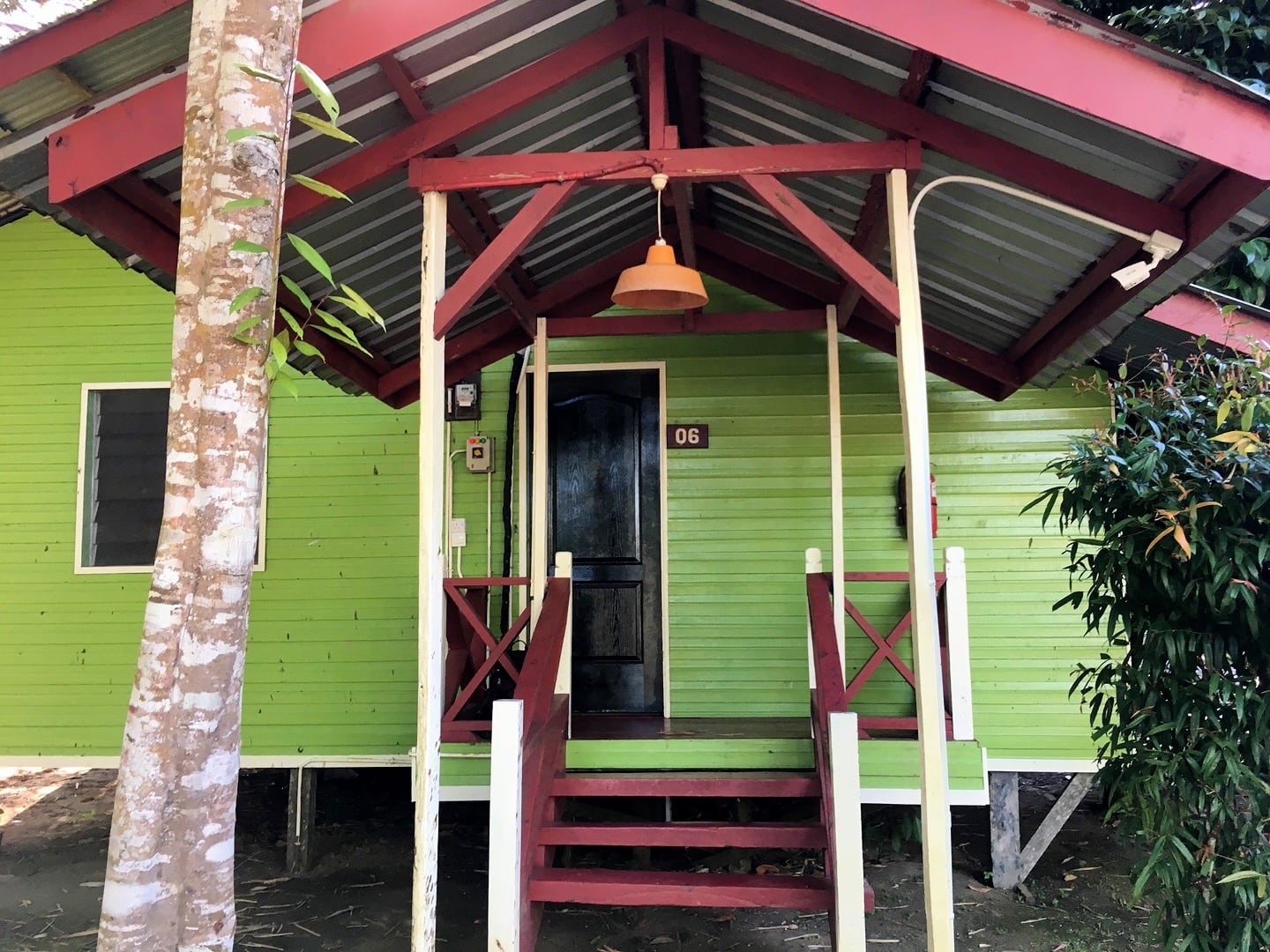
Our cabin, which, lucky for us, was the only one located right across the road from the riverside restaurant (meaning—you guessed it—baby monitor reception!)
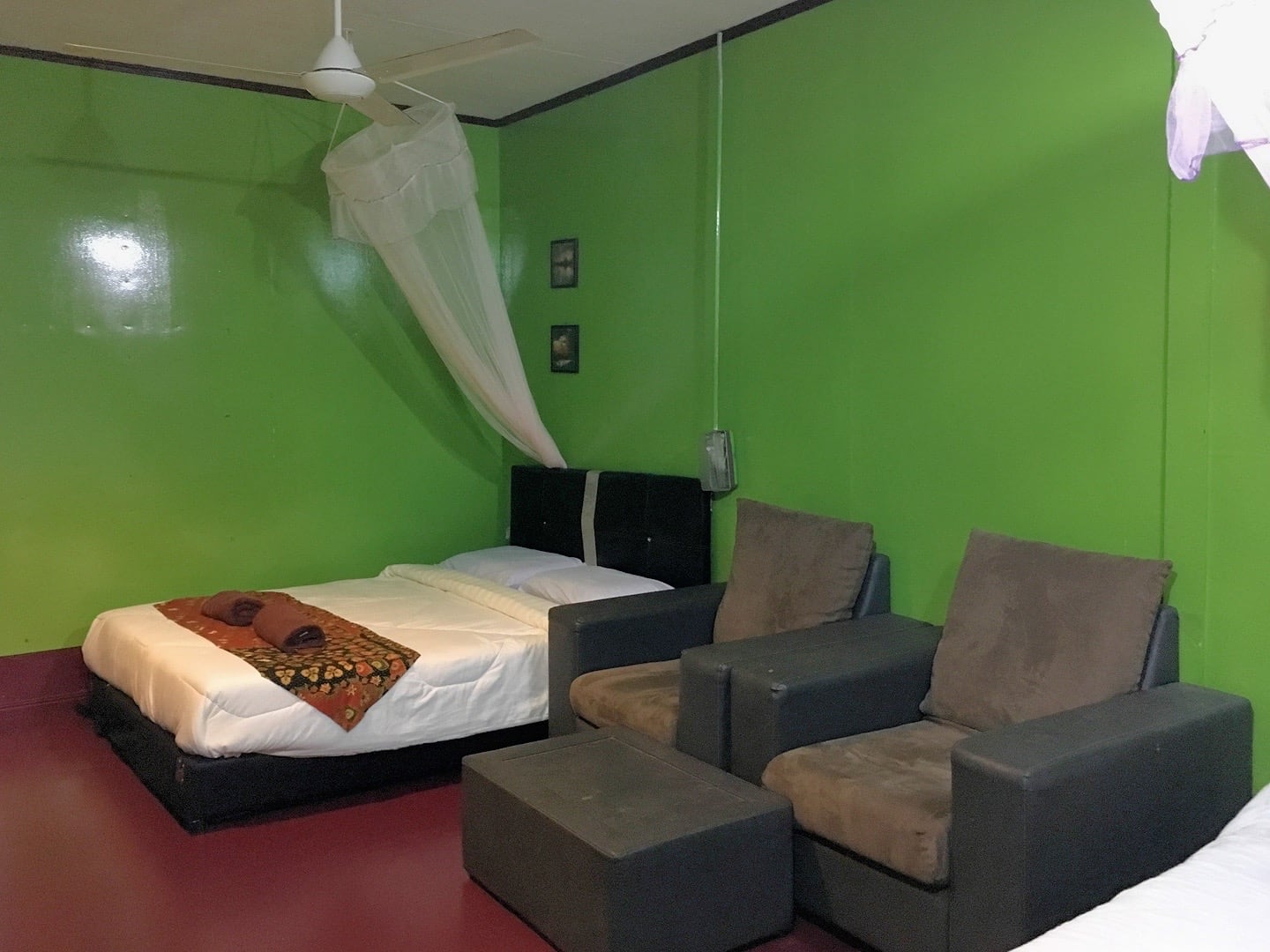
Not only is it a GREEN view outside, it’s inside as well!
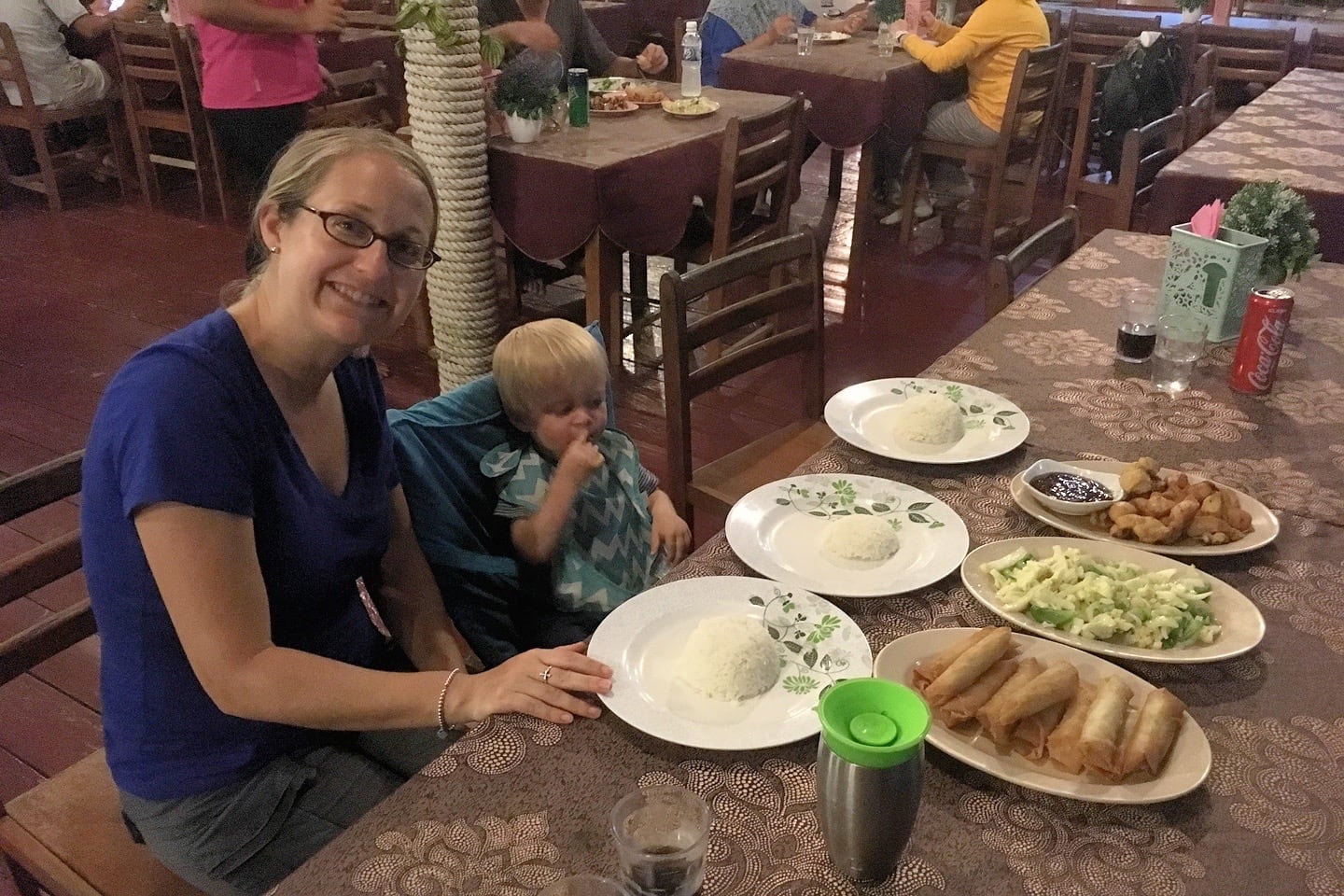
First night’s dinner: A fry-fest of delicious local specialities. Yum.
With full bellies, it’s time to go see some critters!
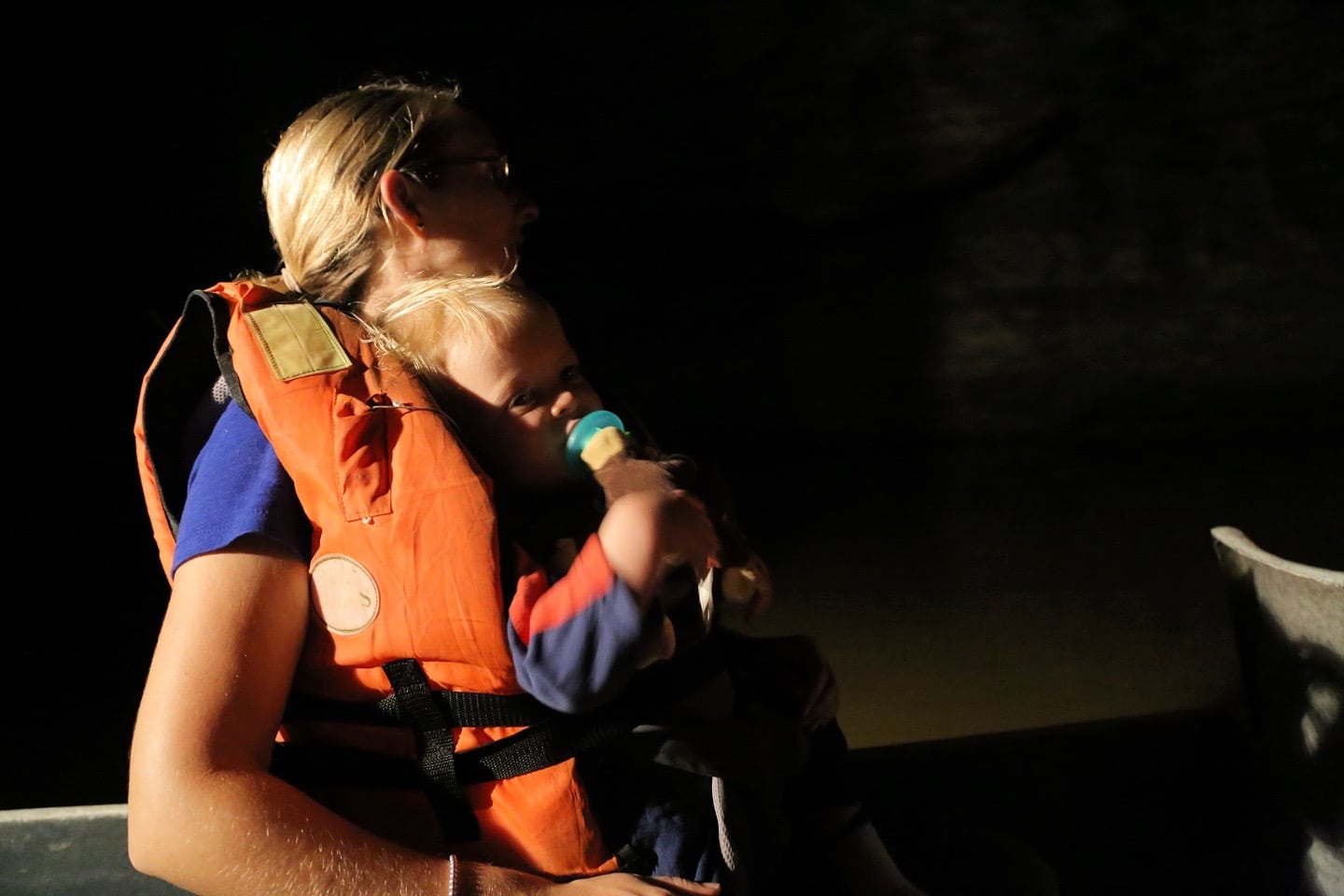
As I said earlier, we moved up the night cruise a day to take advantage of the fact that Noe had had an awesome late afternoon nap and that we had no early morning activities scheduled the next day (all the fun considerations that go into adventure traveling with a toddler).
This was our first of three boat treks we’d take up and down the Kinabatangan River during our stay.
On this one, our English-speaking guide also operated the boat—motor tiller in one hand, spotlight in the other, which seemed to work well at night as when he would catch the eye of something, he could immediately maneuver the boat to get closer.
I don’t have photos of all the critters we saw, given that it was night and extremely difficult to get clear shots, but I did get a few clear ones—surprisingly, all of birds.
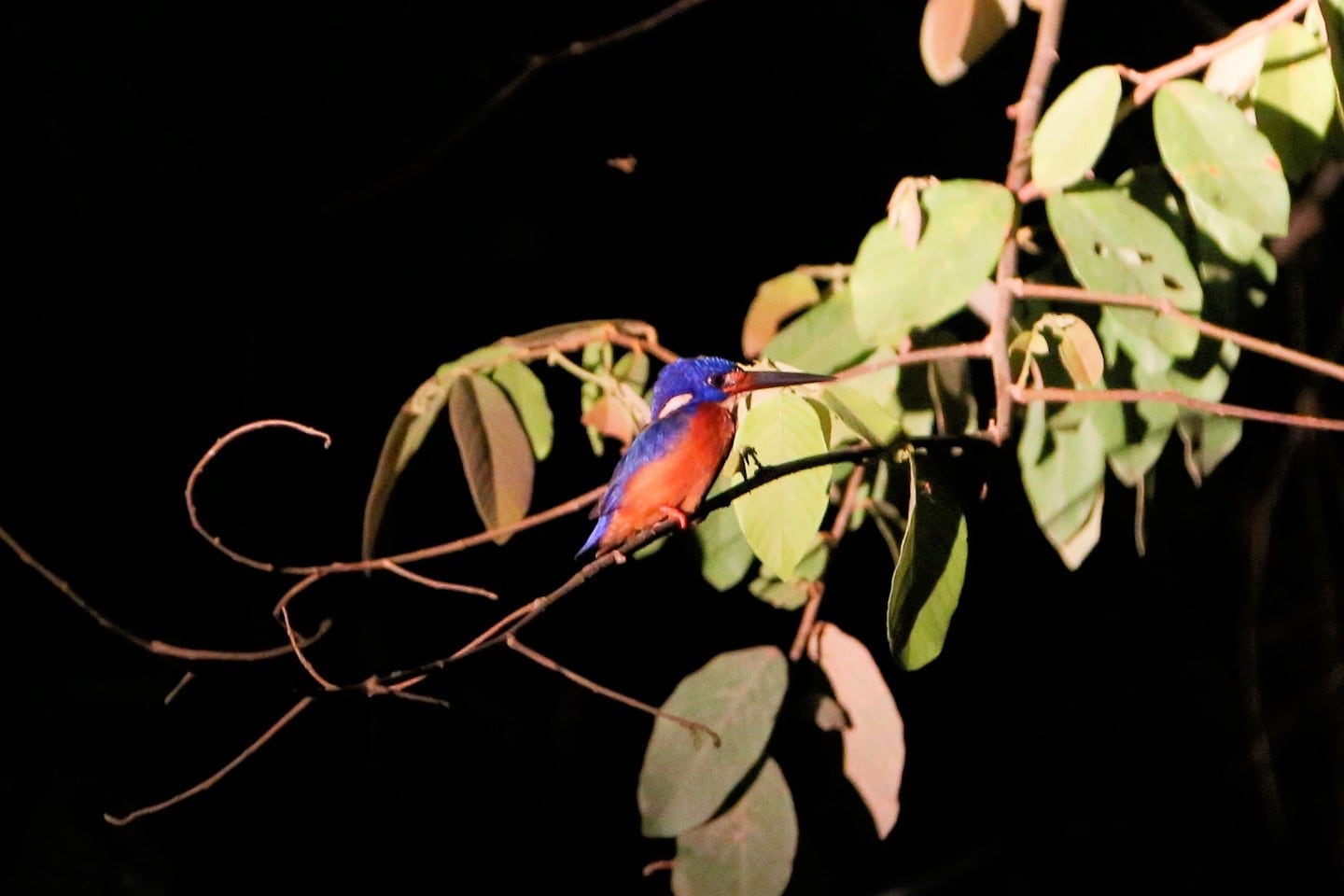
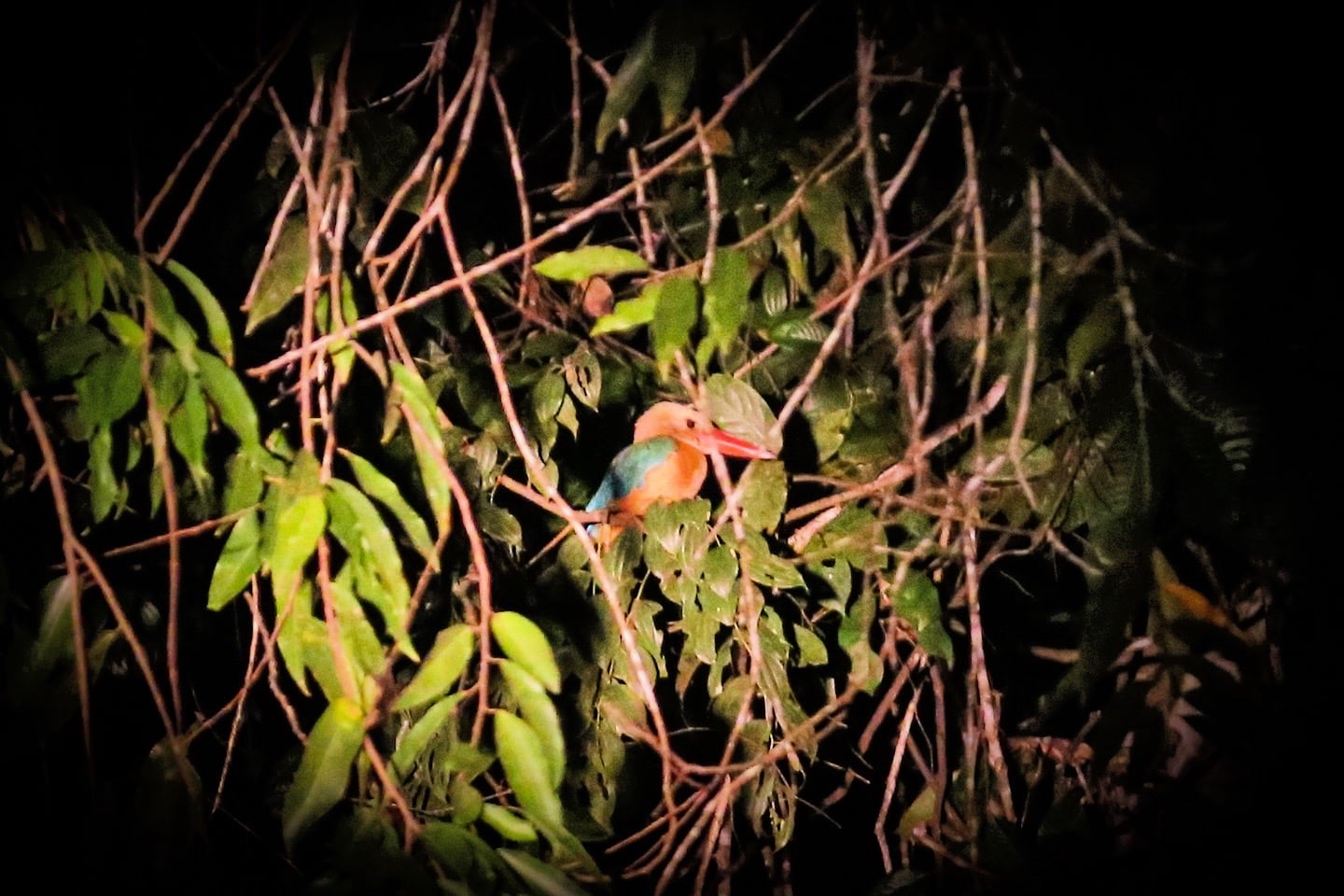
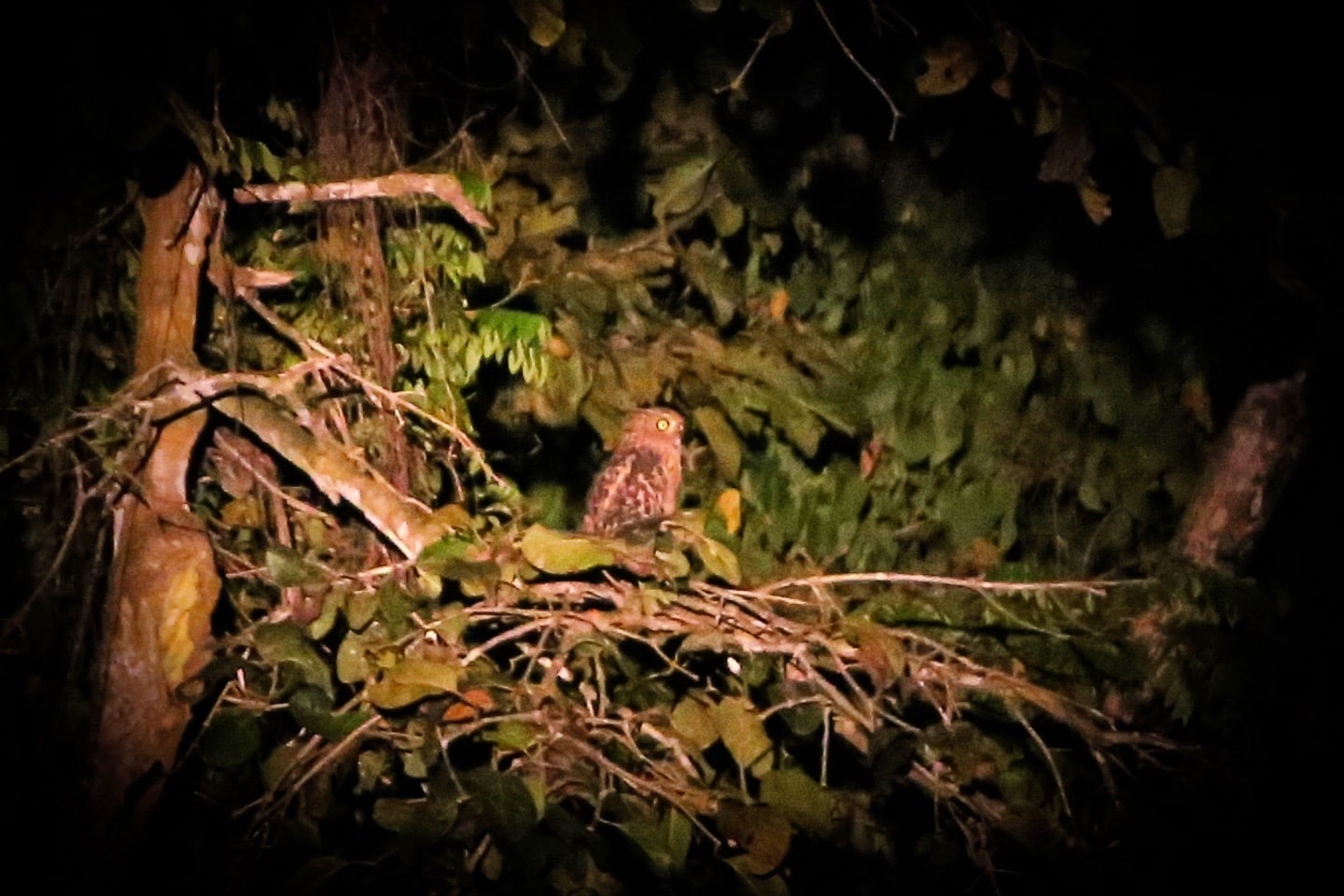
We also saw a couple of saltwater crocodiles, a large tree snake, and a variety of other birds.
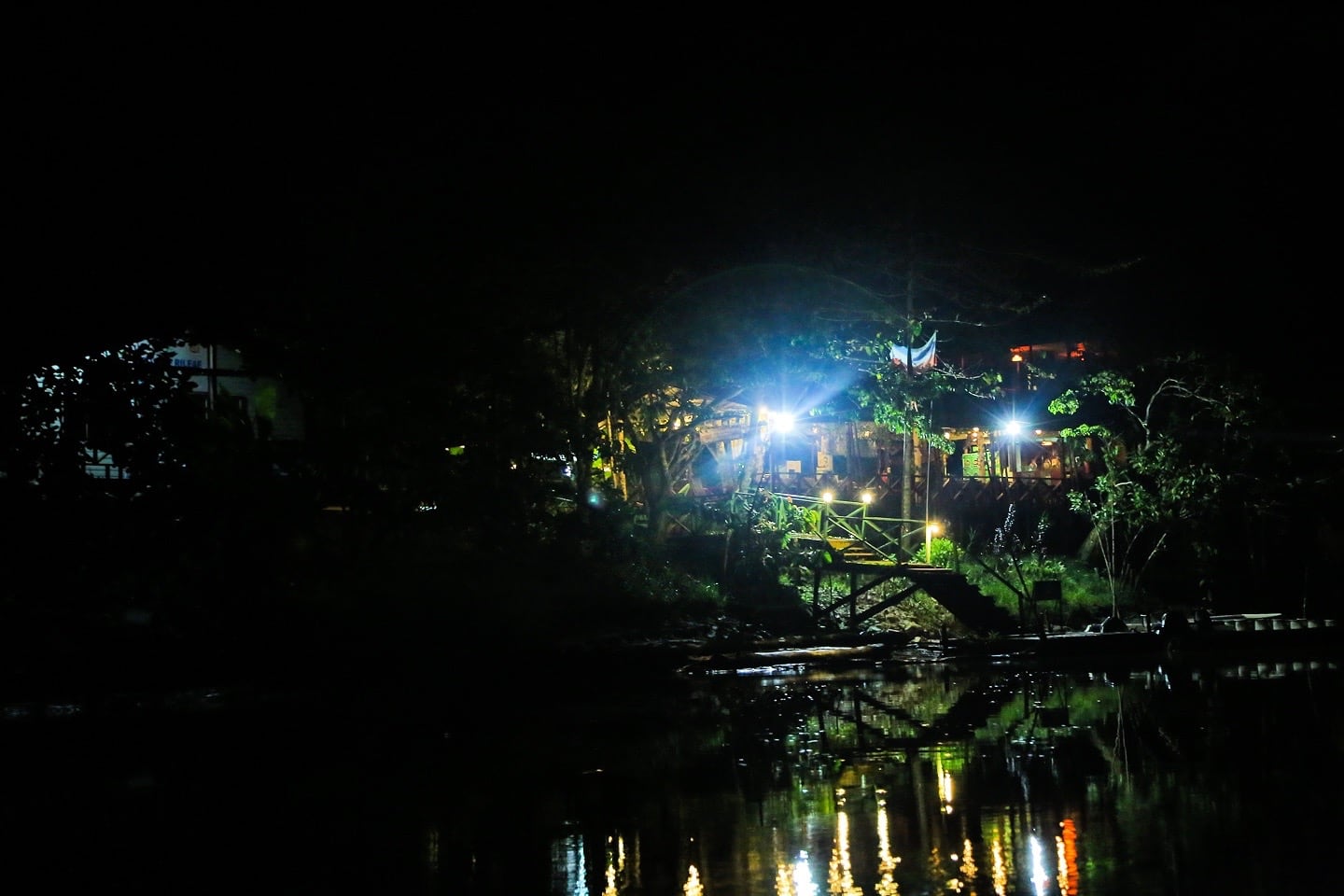
Just over an hour later, we returned to the lodge.
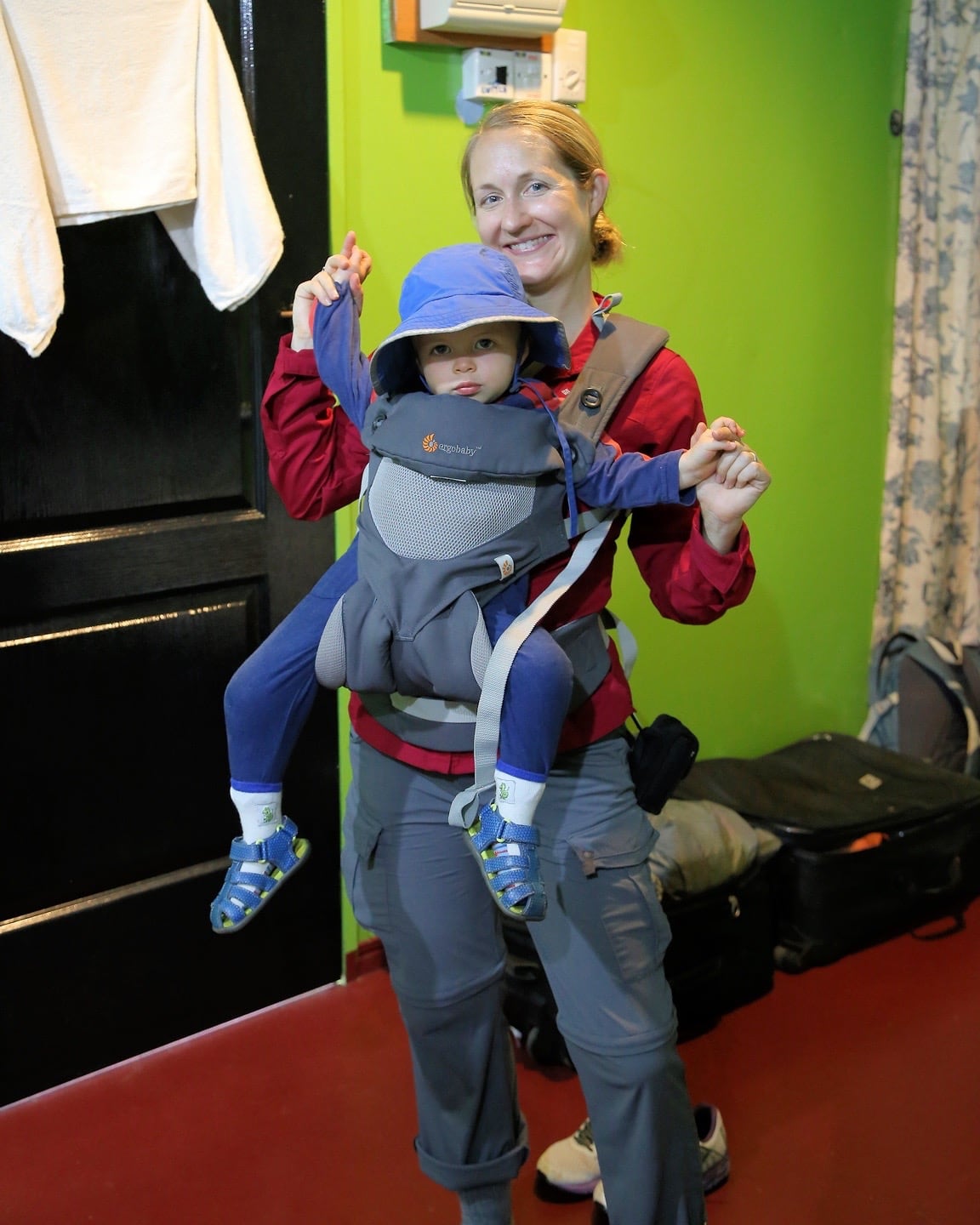
Day Two
All suited up and ready to go trekking through the jungle!
Except…
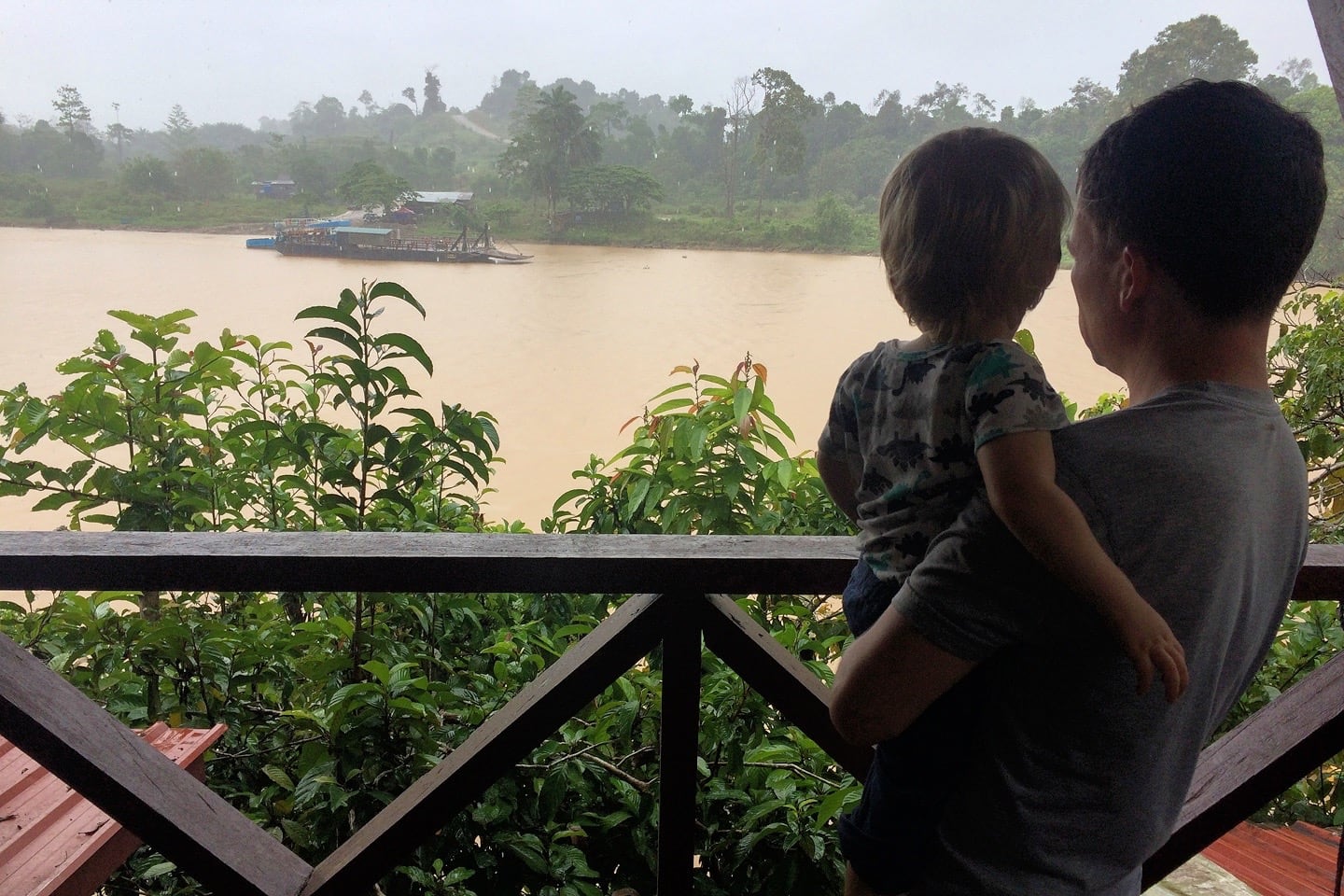
Rain. Lots and lots of rain. Yesterday was beautiful of course. Same thing happened to us at the Tip of Borneo. We arrived to gorgeous weather, only to wake up to a tropical downpour throughout the morning. I had a strange feeling this my happen the day before, which also factored into us moving our night time cruise up a day.
So, here we are, in the upper level sitting room of the lodge, watching the rain come down. It is nice to have a bit of break with no itinerary, but definitely a bummer to miss the jungle trek.
Either way, Noe seemed to take it in stride, playing with his foam alphabet…
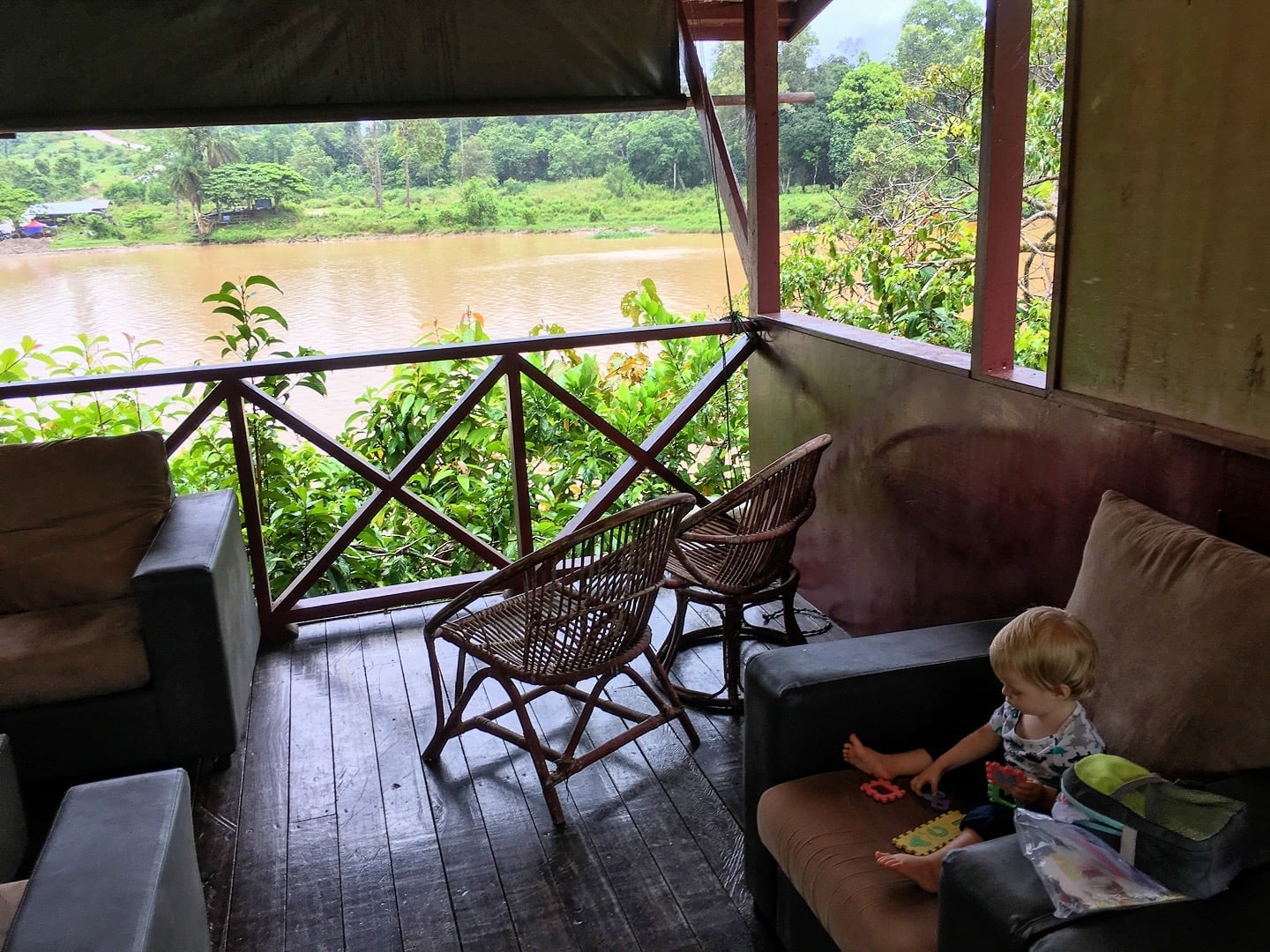
Keeping tabs on the ferry…
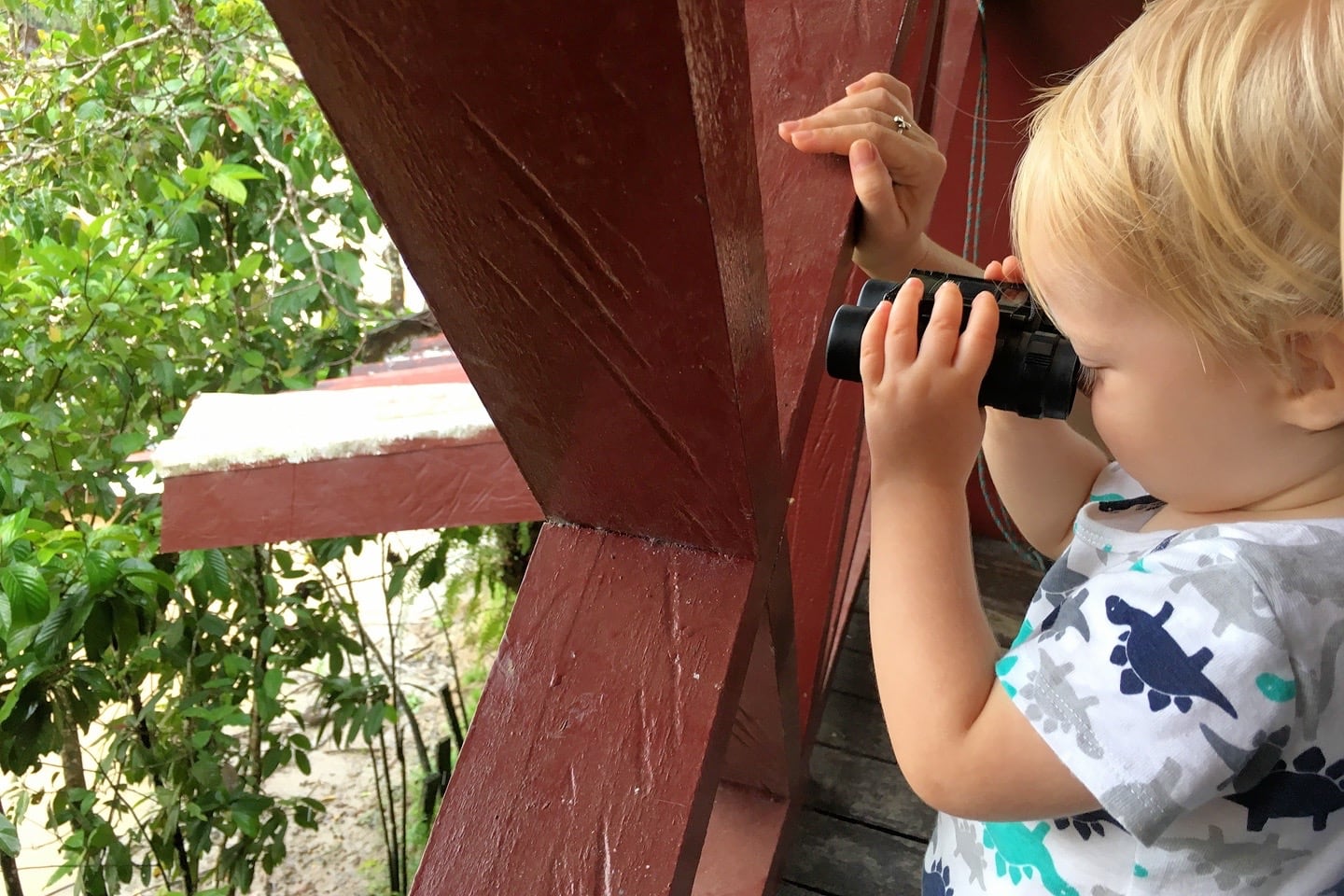
Reading up on how to prepare for worst-case scenarios…
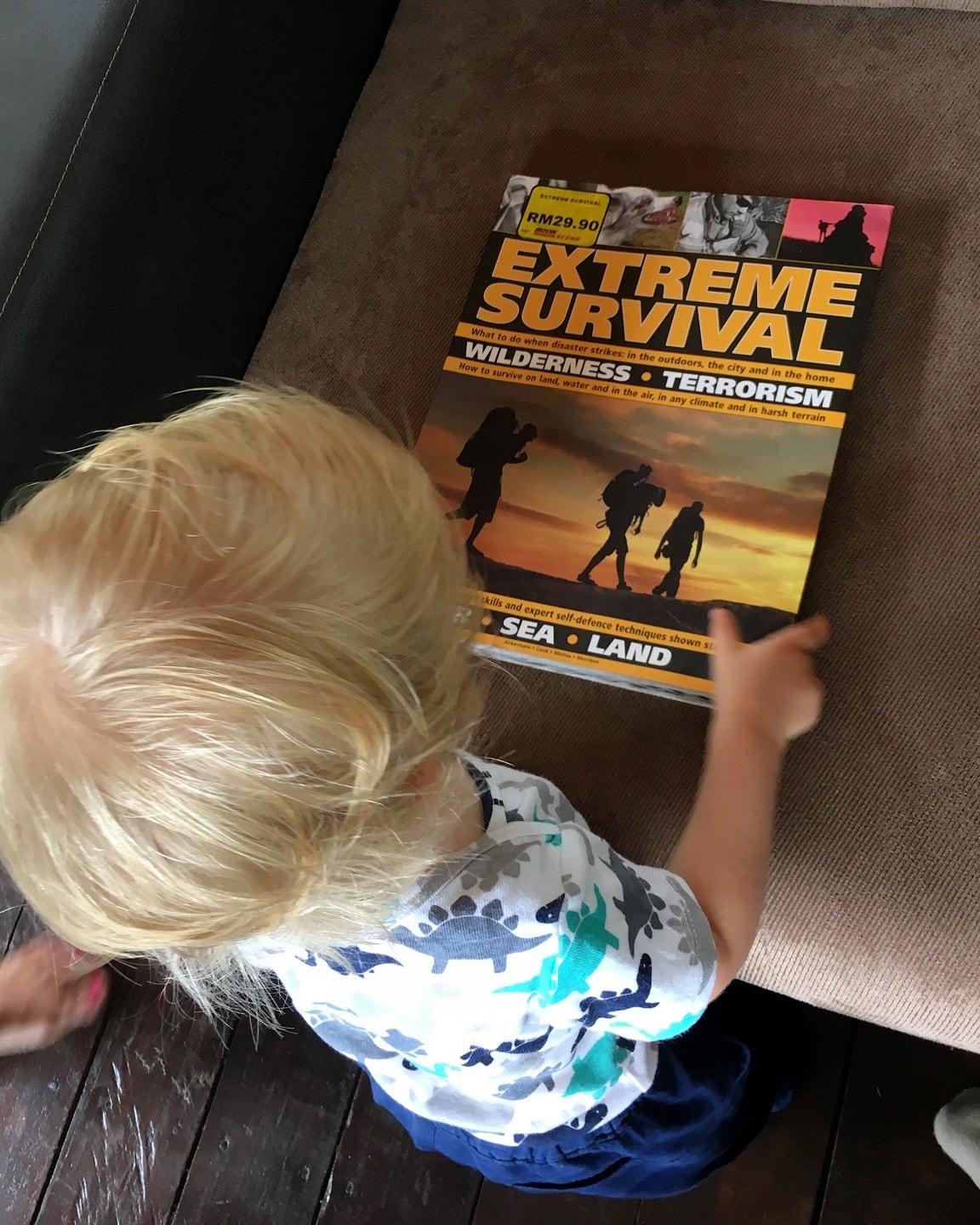
So, while we’re waiting out the rain, I’ll finish my little bit about the Morisem ferry.
For years, a bridge was slated to be constructed in this very spot (just to the left of the lodge, and over to where the current rudimentary ferry terminus is). There’s not a lot on the other side to warrant such a sizable infrastructure project for the area. But there is one thing—palm oil plantations.
Palm oil plantations are controversial in themselves, as many around here put the large-scale decimation of Borneo’s magnificent rain forests squarely on the shoulders of this industry. But we won’t get into all that here.
Basically, a bridge replacing the ferry was to be built here.
It didn’t matter that both banks of the river (and both sides of the bridge) were wildlife refuges home to several of the planets rare and endangered species, and that surveys taken had demonstrated a sizable impact on the areas habitat.
It didn’t seem to matter that it would be the only such bridge in the region and would dramatically alter the natural scenic quality that attracts tourists (and their money) the world over (an industry that has a much farther-reaching and more positive impact on surrounding communities than palm oil).
And, it also didn’t seem to matter that there are very few communities on that other side that would stand to benefit from bridge access versus ferry access.
For a long time, the bridge appeared to be a given, and area residents basically essentially lost hope that anything could change that.
The project was ultimately halted in 2017 through the efforts of Bornean and international conservationist organizations, with famous broadcaster and naturalist David Attenborough lending his voice to the cause.
The central issue that sealed the fate of the bridge were mounting concerns over dwindling populations of pygmy elephants, given that the bridge and slated highway crossed one of the key migration paths of the elephants—hundreds of elephants cross all at once at various times of year.
In the end, many agreed that it wasn’t so much a battle for the pygmy elephants as it was a battle for common sense, given that the bridge was largely unnecessary in the first place, and the tourism industry stood to lose more from the construction than the palm oil industry stood to gain.
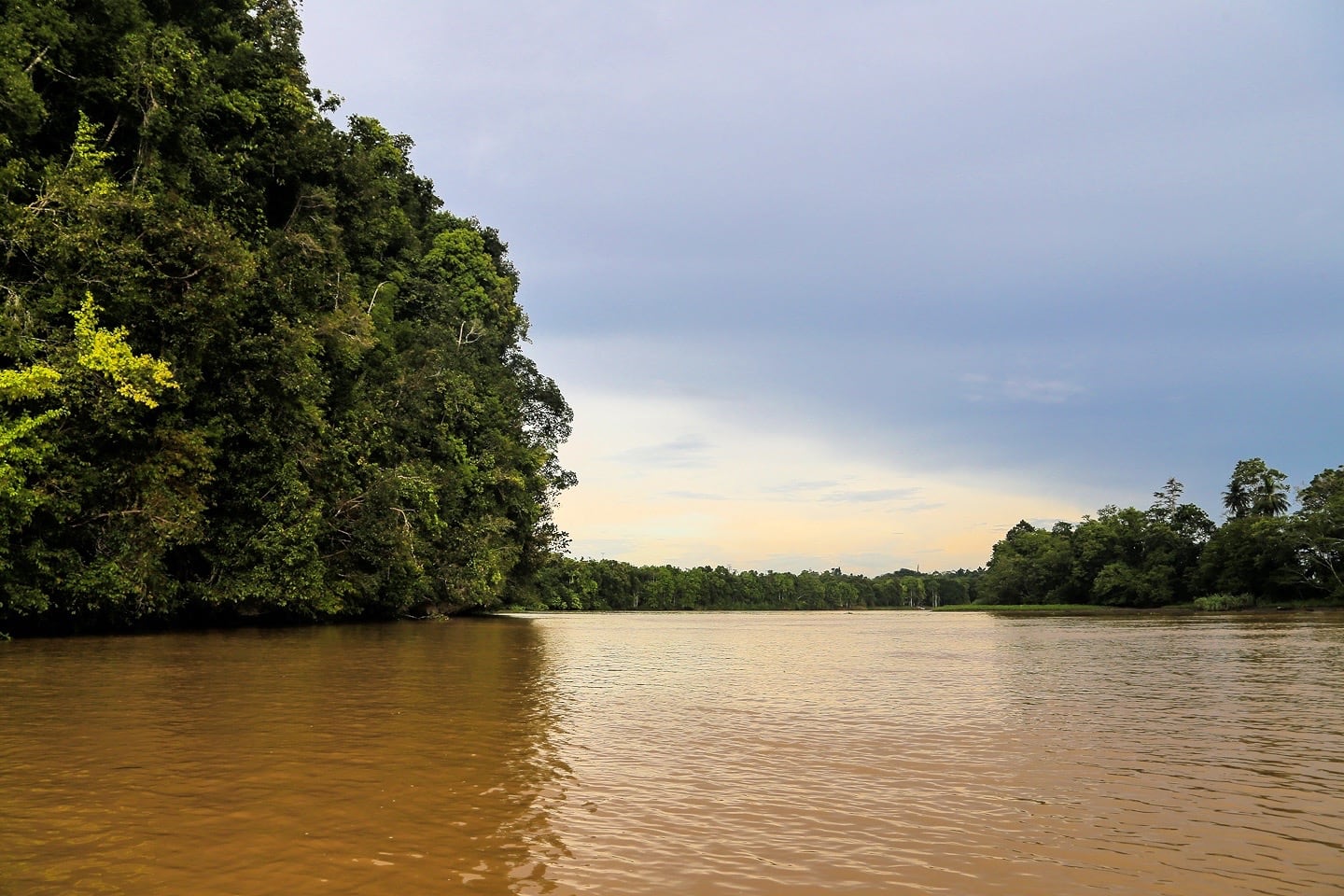
After lunch, the sky cleared enough to provide a dry cruise down the Kinabatangan River. We’ll see who’s out and about after the storm.
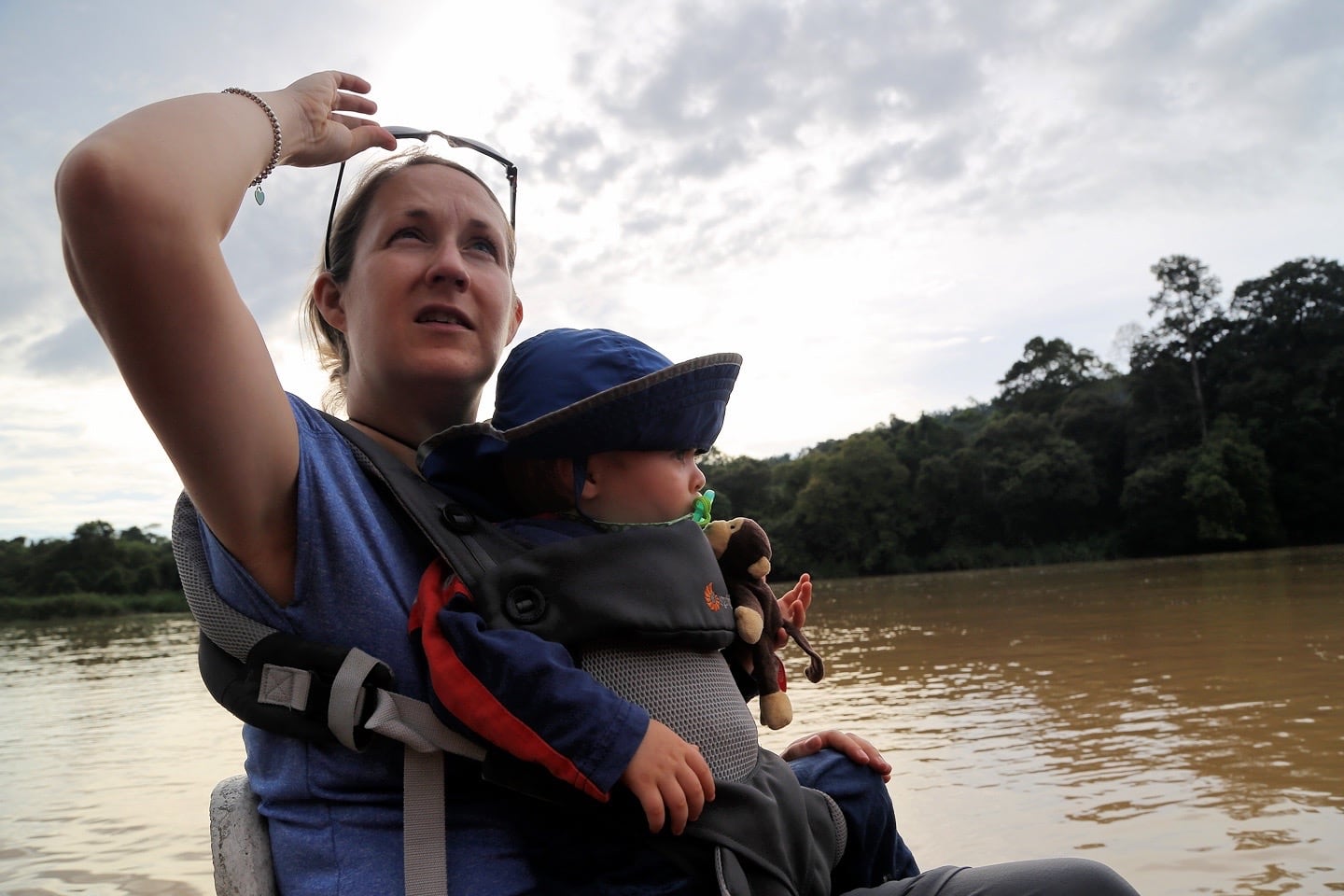
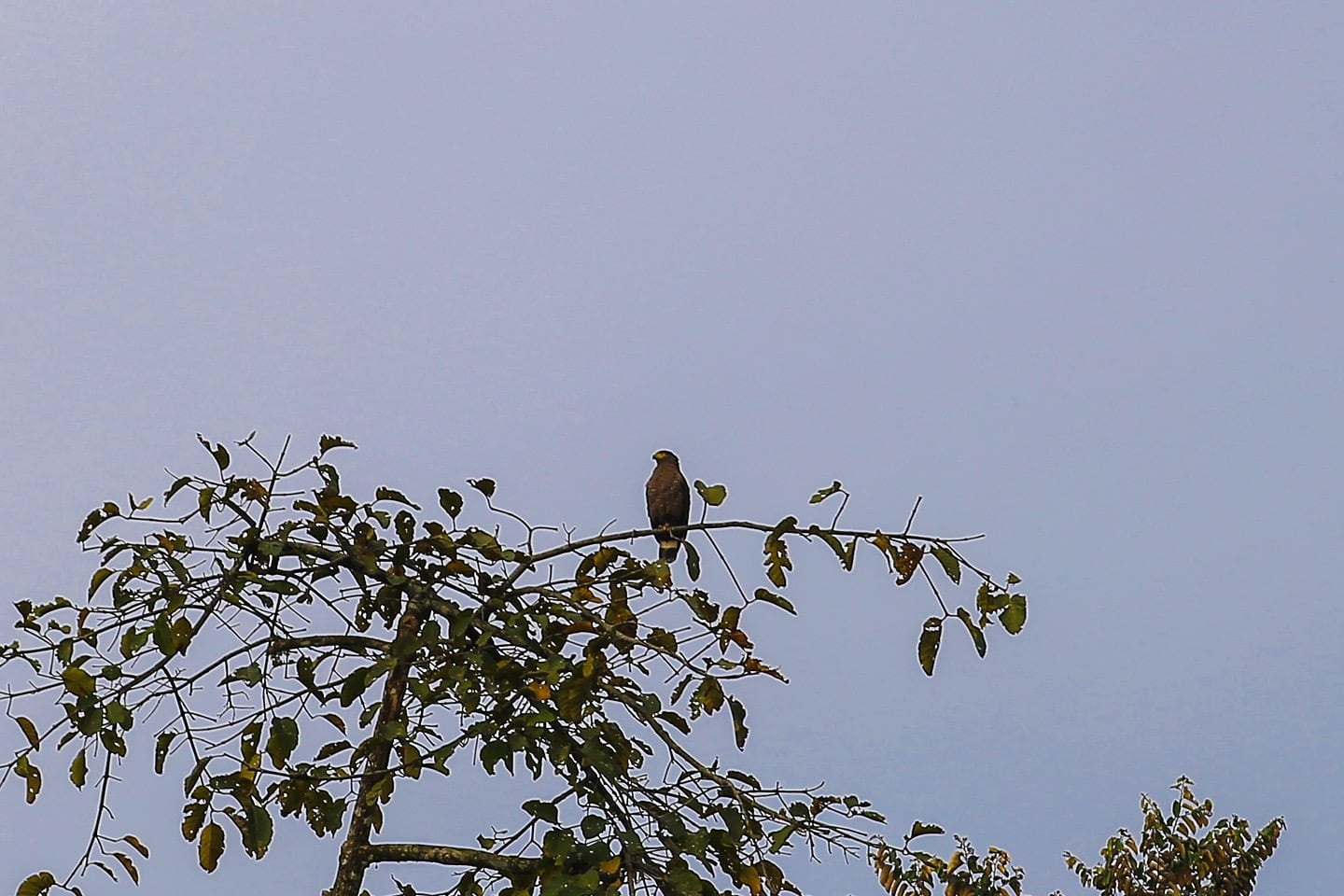
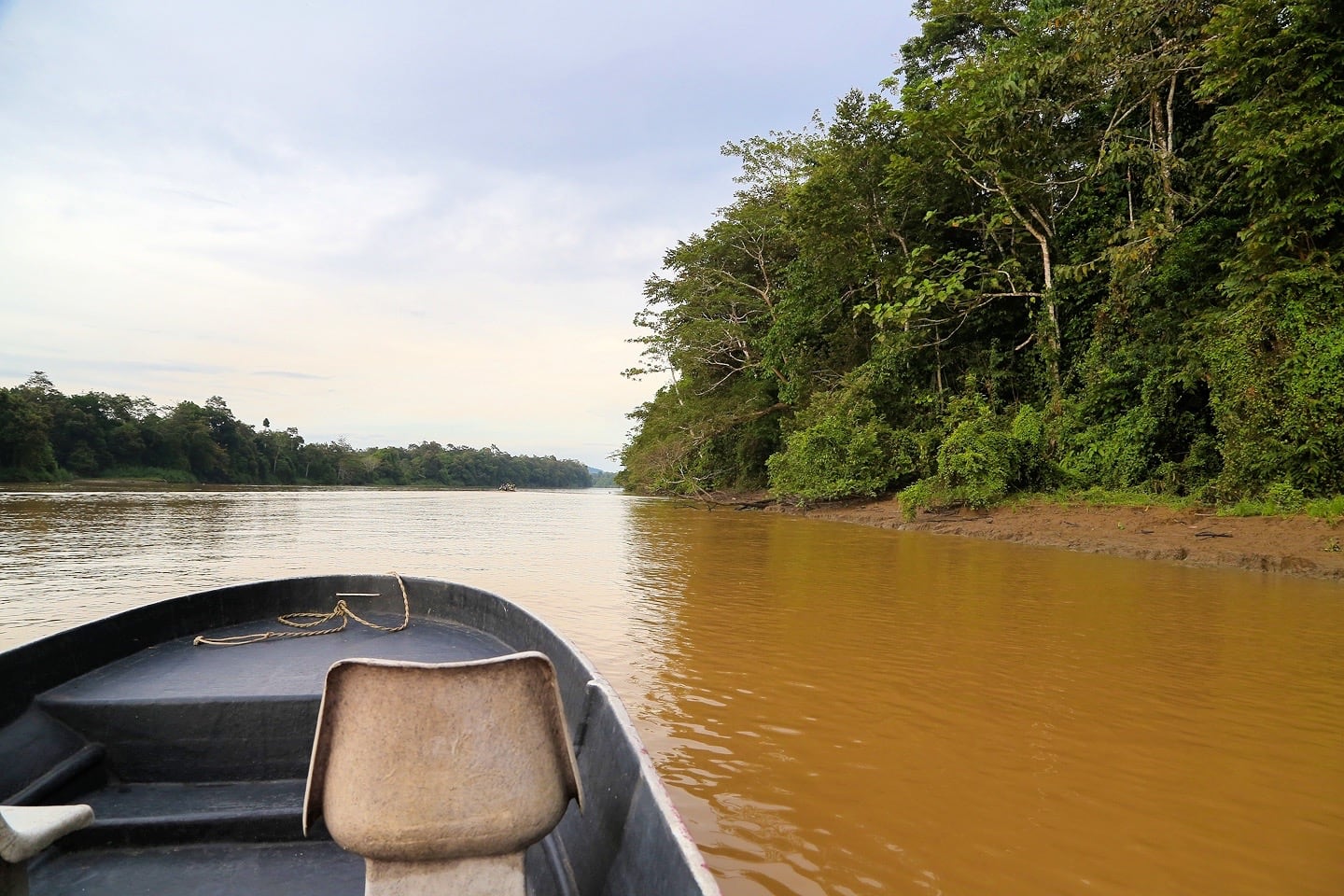
Heading down river this time, it’s not long until we spot our first monkey. Then another. And another. And another!
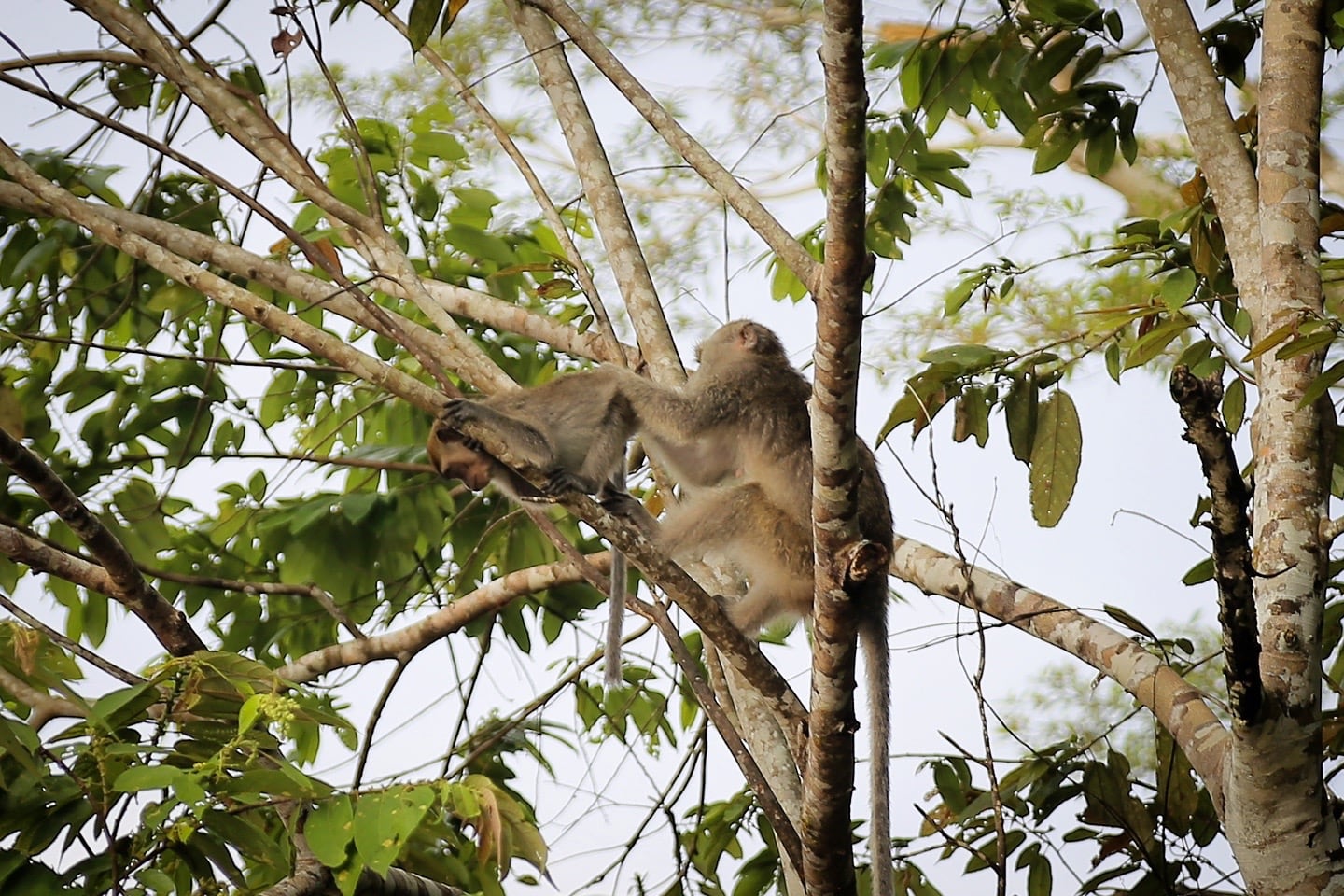
Macaques, doing what macaques do best: playing and cleaning each other in trees!
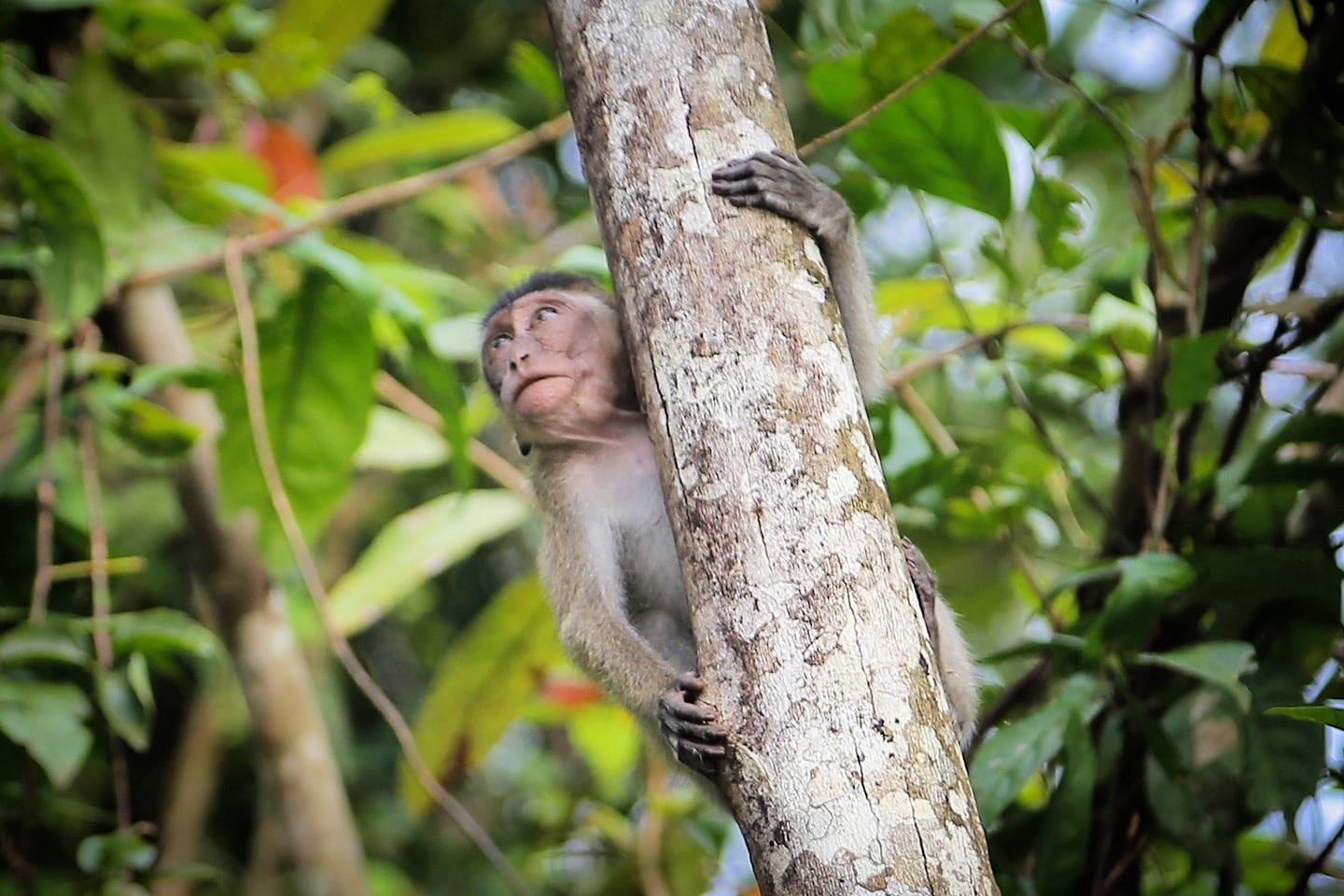
Admittedly, I don’t own a proper wildlife lens—my midrange zoom only goes up to 105mm on the long side of things (full-frame Canon 6D). So, we’re pretty dang close to these monkeys, maybe a couple of meters in some instances.
We’re on the boat and several of these guys are playing on trees over-hanging the river bank. We sat and watched them play for maybe ten minutes or so. Noe got a kick out of it, as you might imagine.
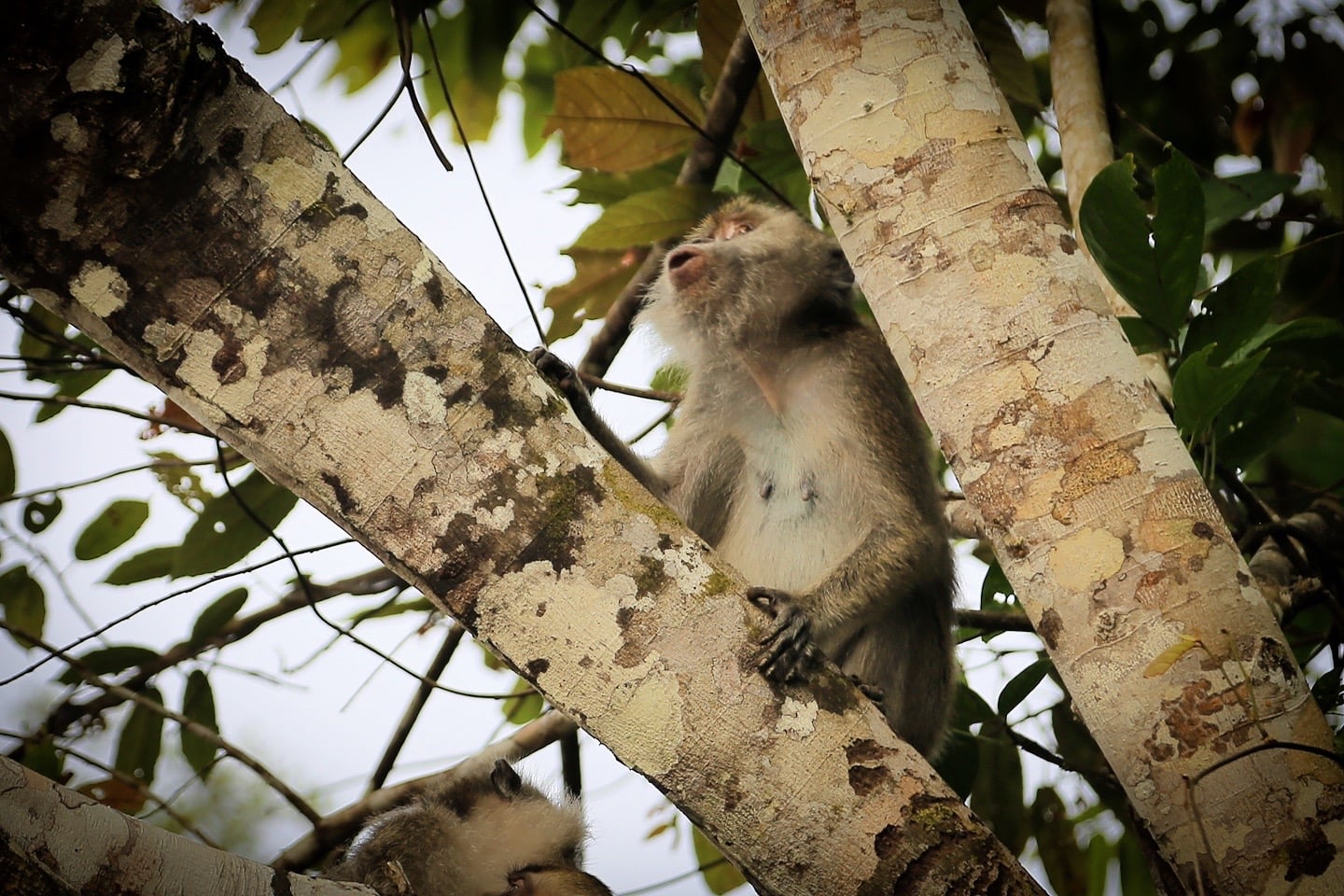
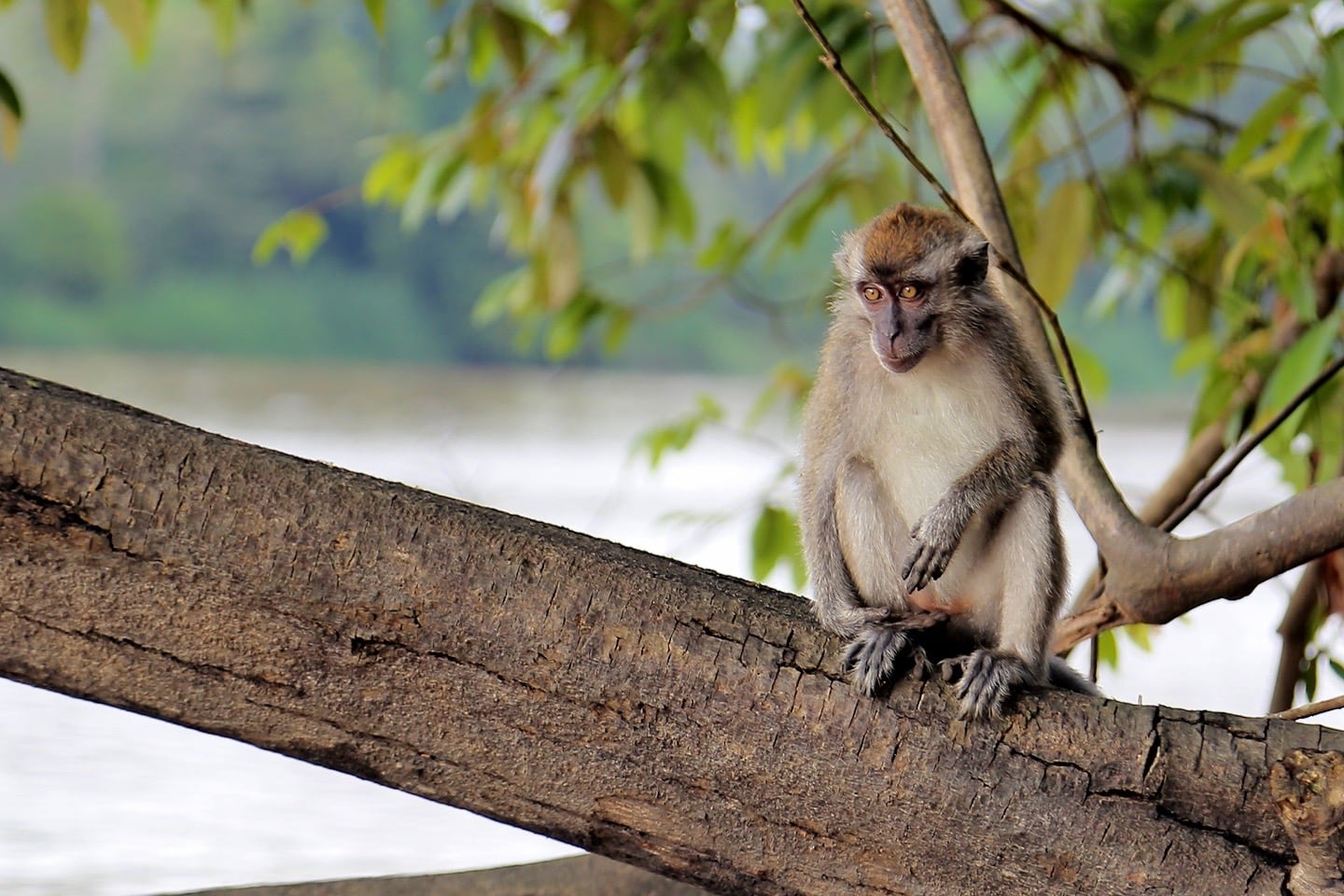
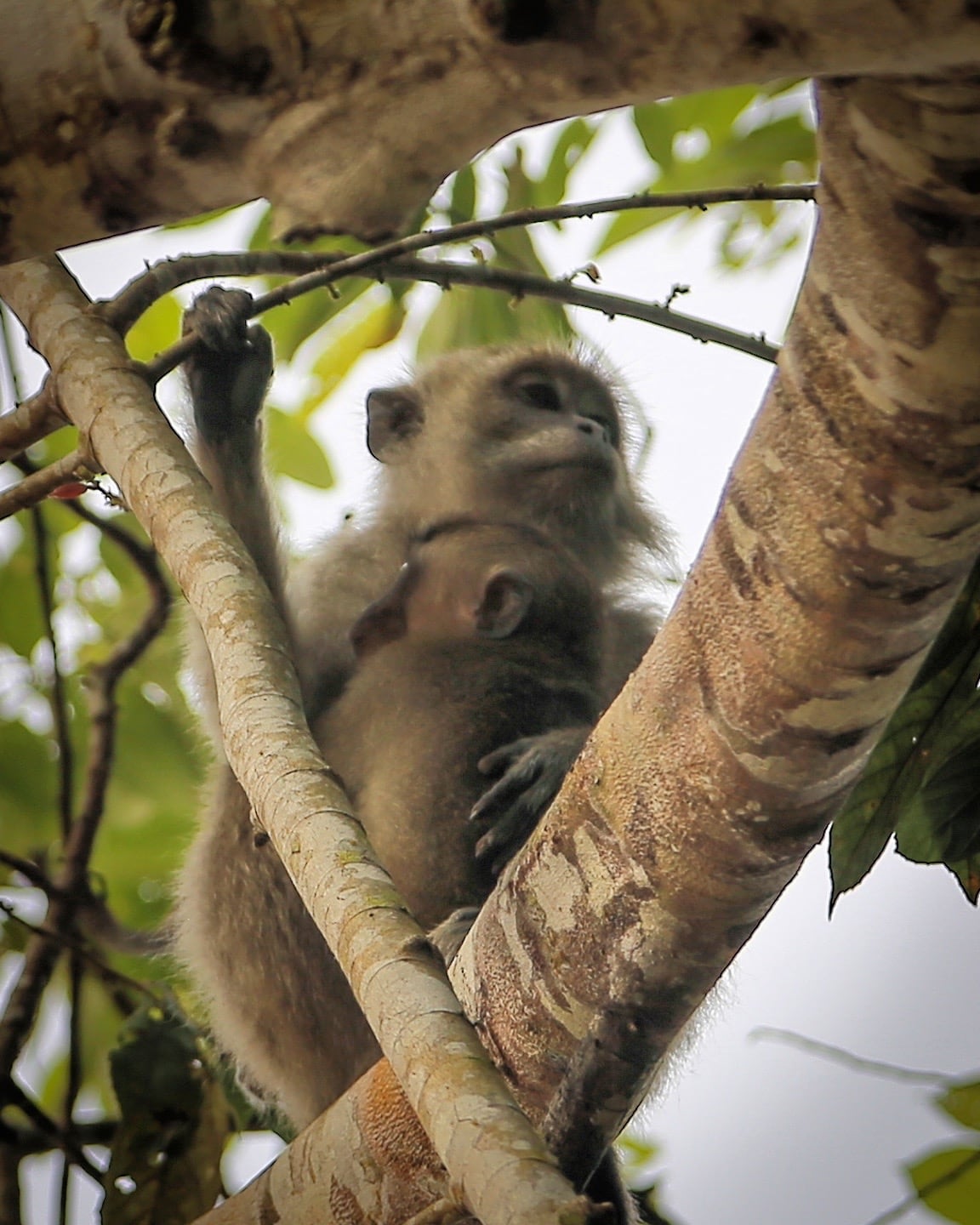

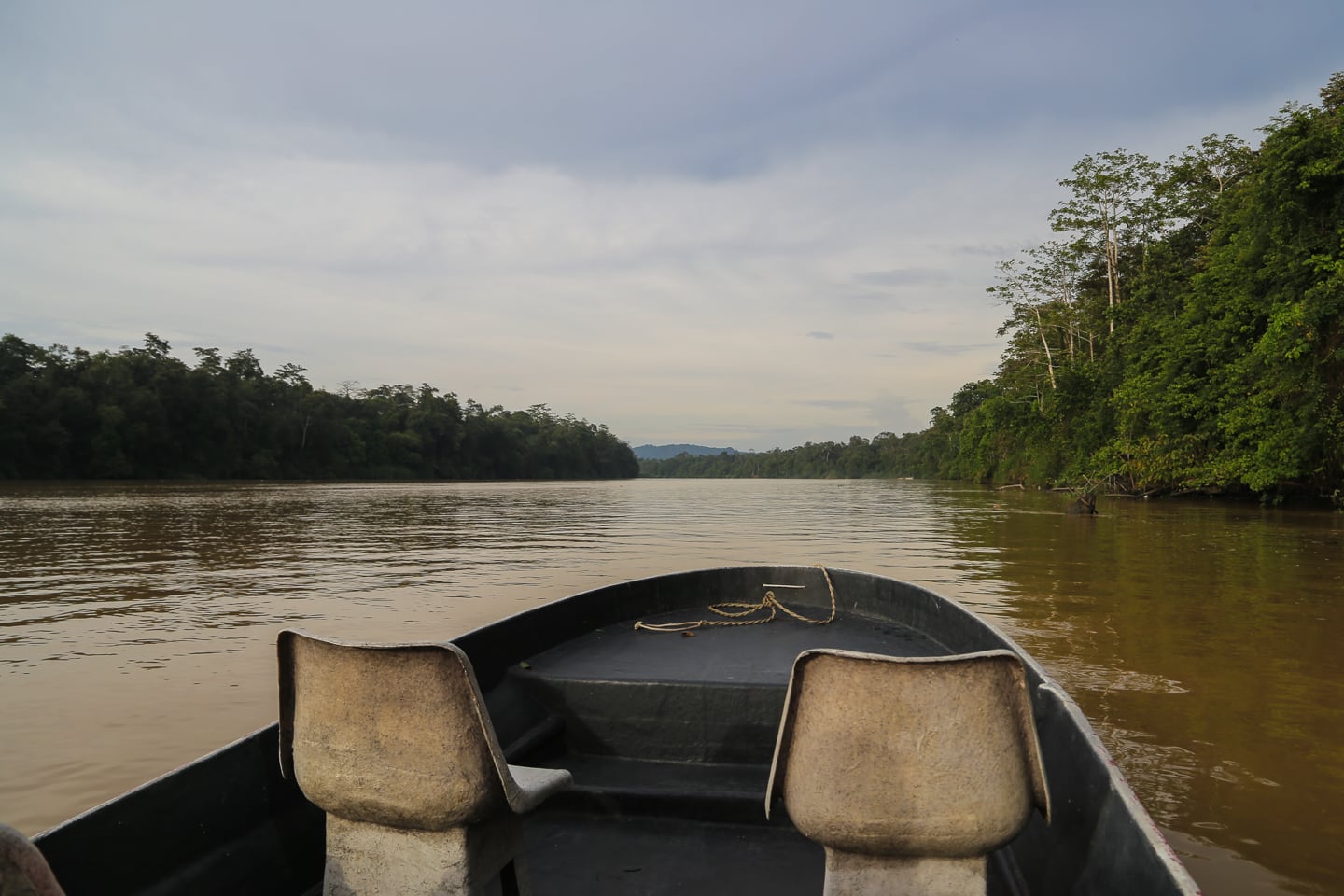
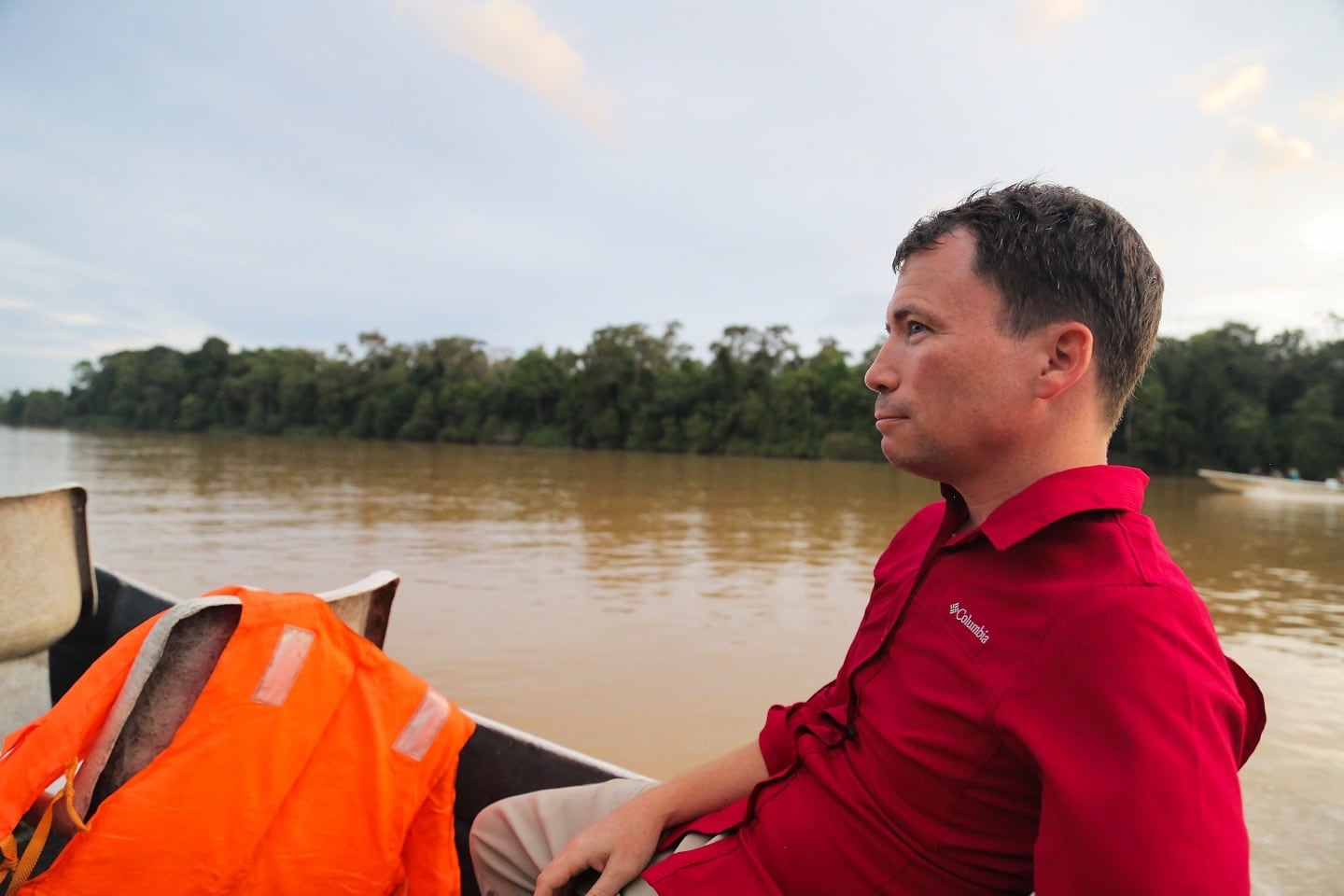
I know that most people sign up for these treks hoping to get a glimpse of Borneo’s famed proboscis monkeys or even an orangutan. One of the highlights for me, however, was seeing large monitor lizards up close, which we did indeed spot on a few occasions.
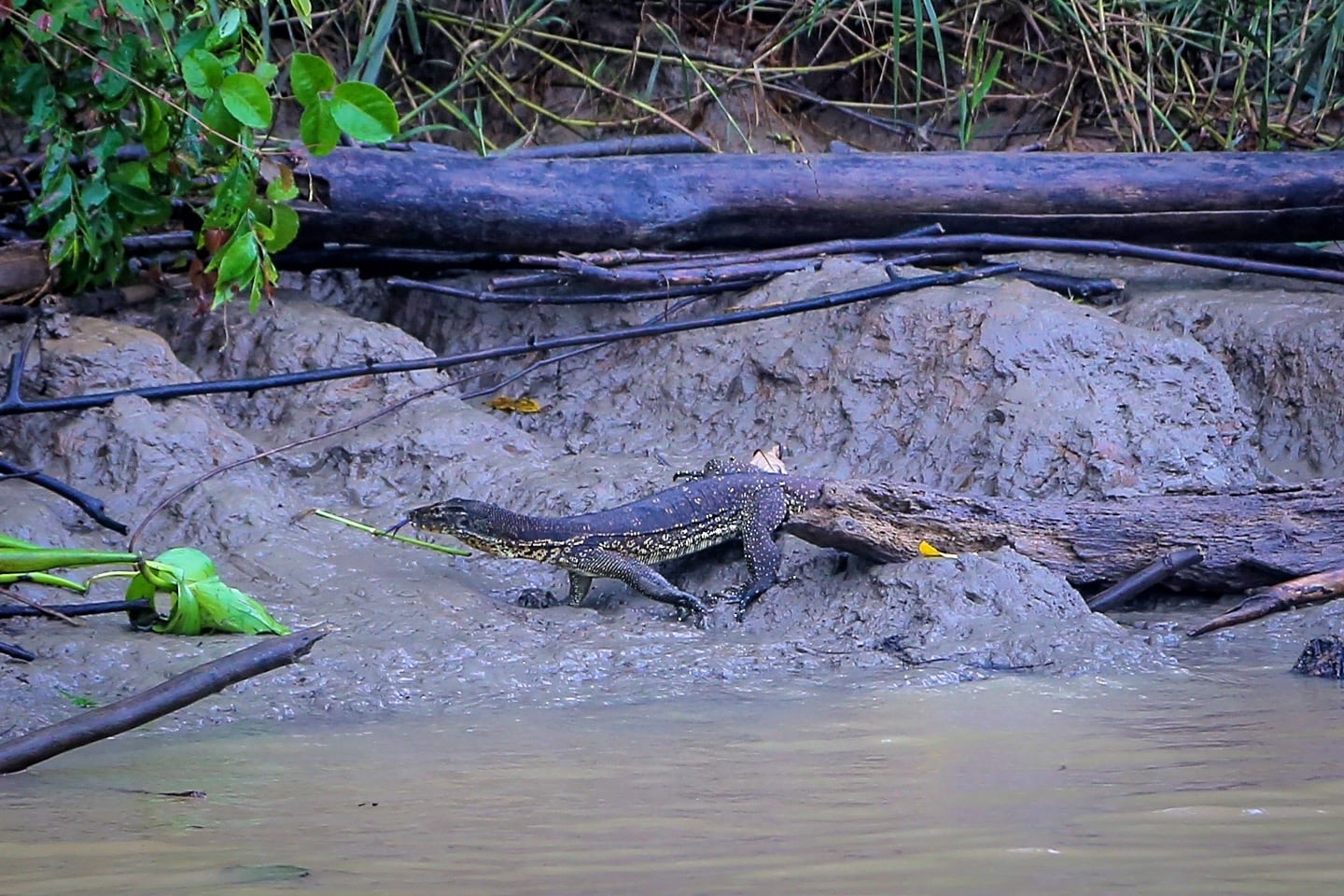
Toward the end of the cruise, we finally got our glimpse of Borneo’s remarkable and unique Proboscis monkey—dozens of them!
We never got as close of a view to them as the macaques (these photos are cropped close), but close enough to see the big ol’ flappy nose that the dominate males are known for.

…and many more females and babies.
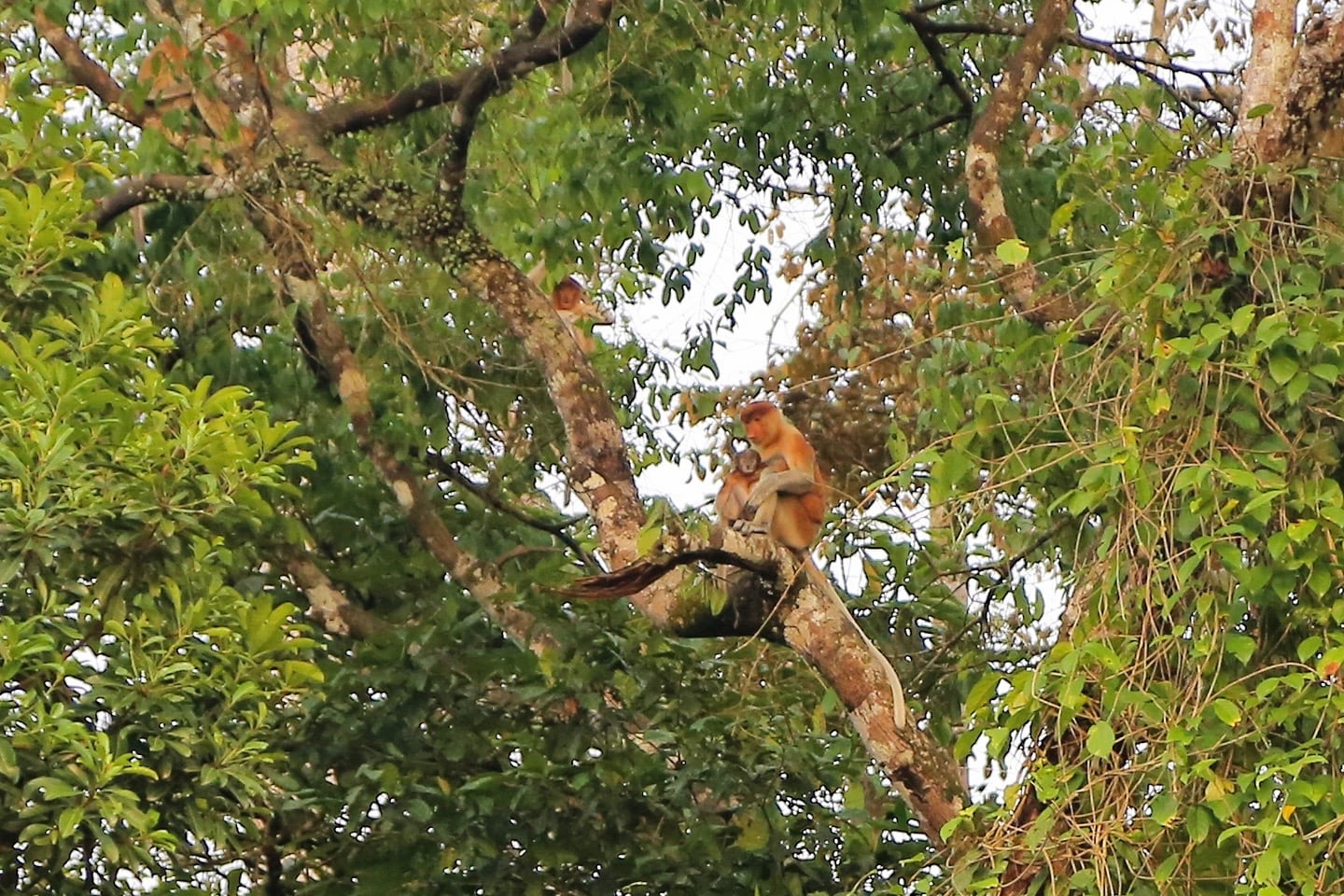
Time to head back for dinner!
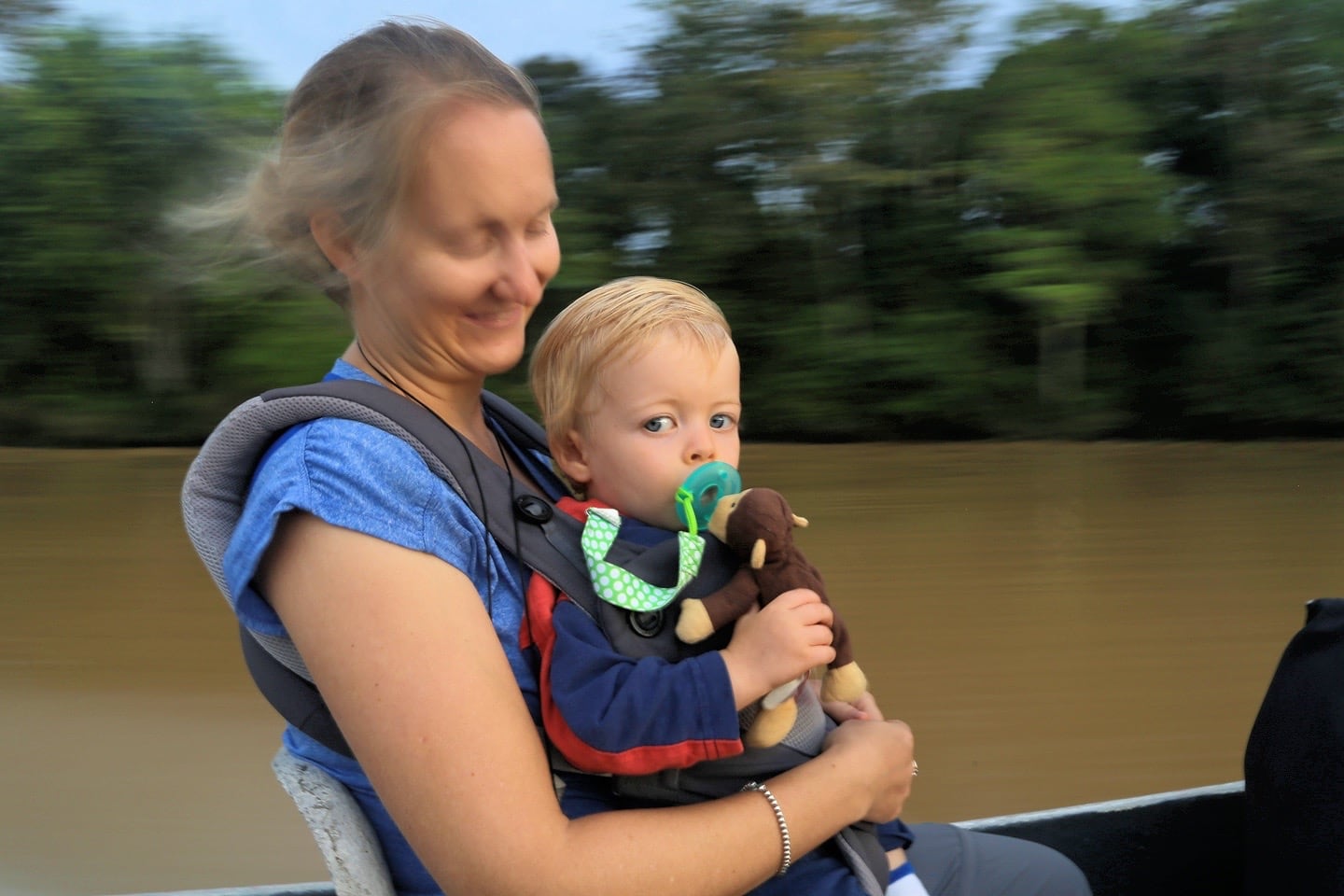
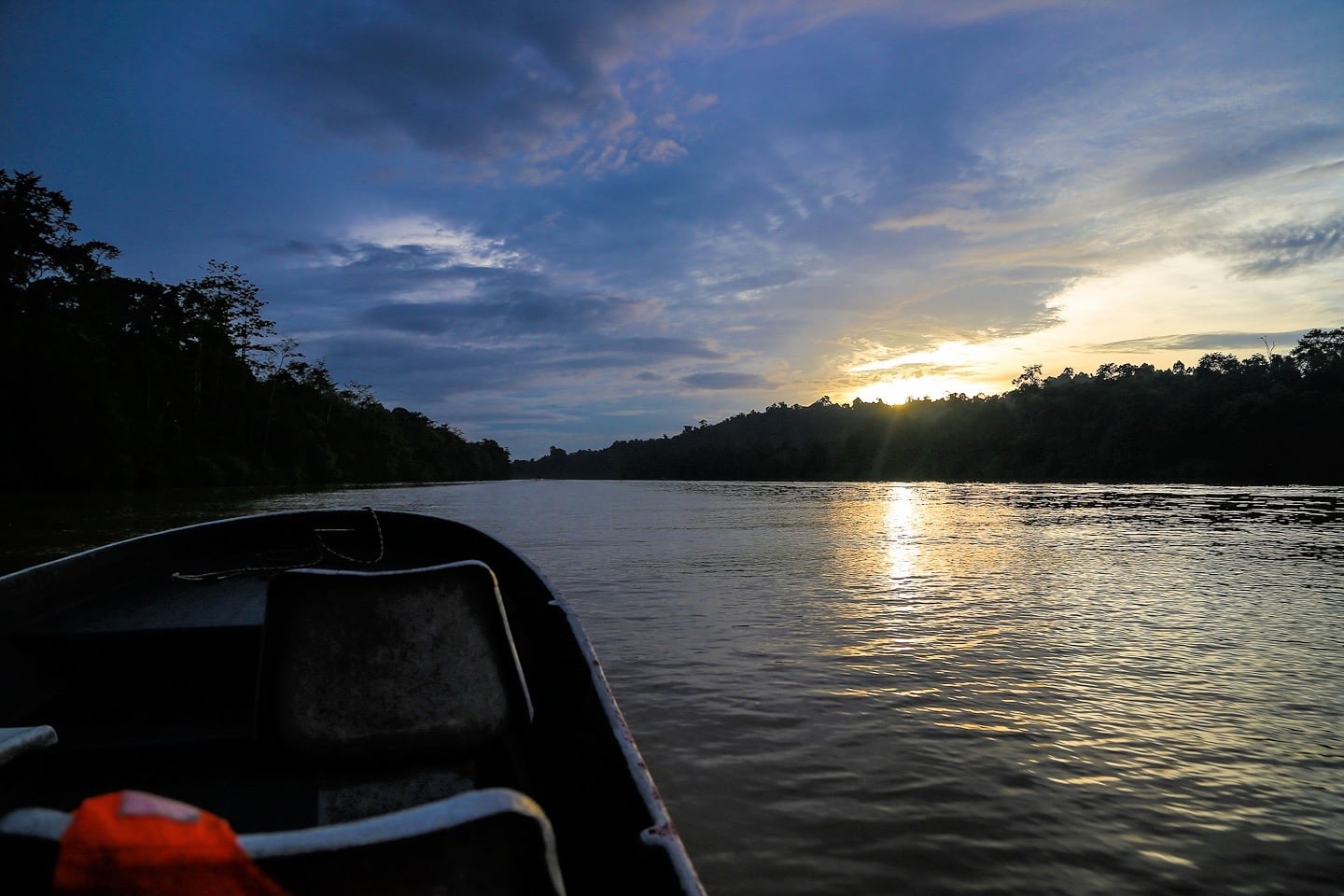
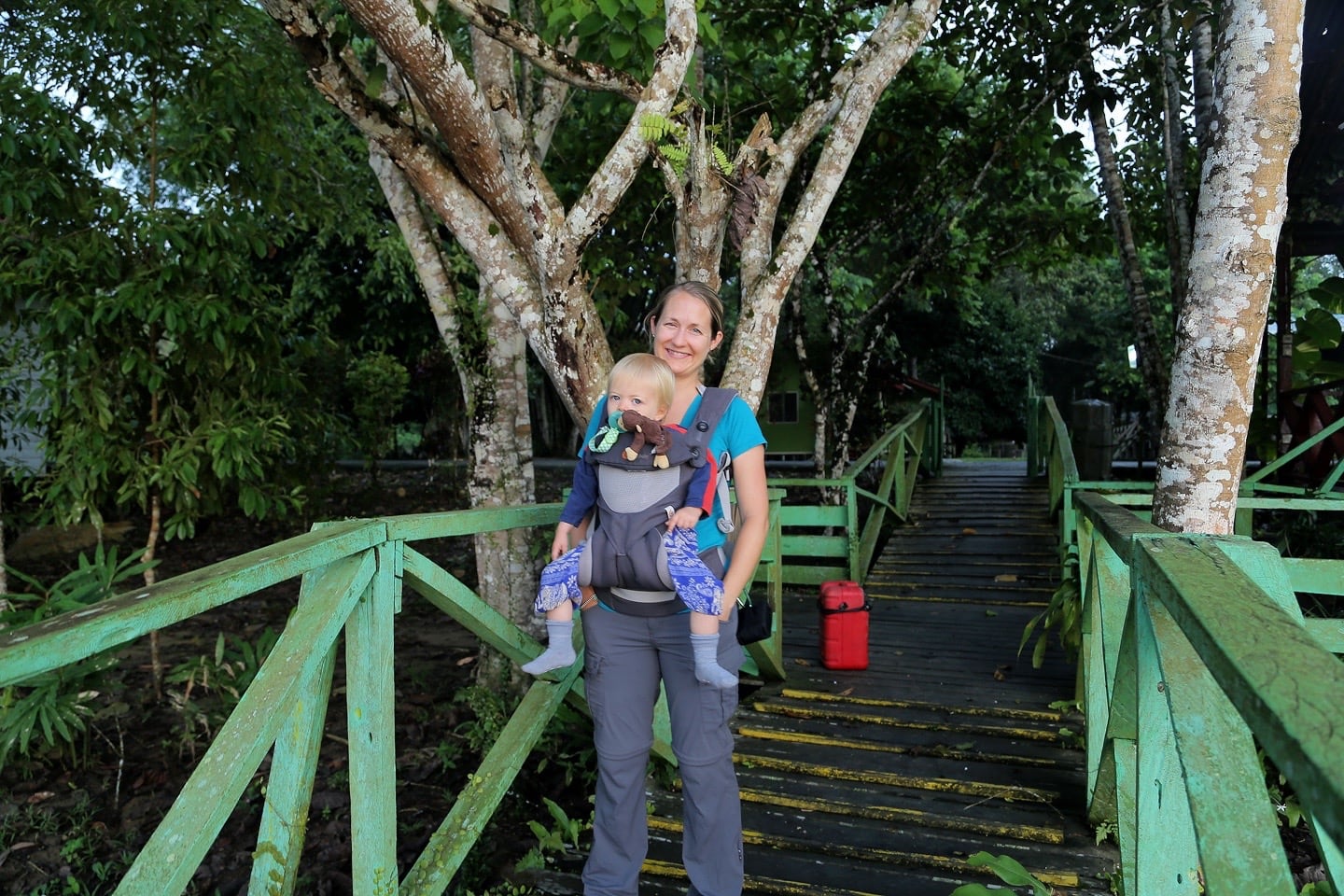
Day 3
It’s 6am and we’re standing on the boat plank. Unfortunately, our guide is not.
We’re told by our limited-English-speaking boat driver that he is “sleeping.” Later, we find out there’s more to the story than that (as I mentioned before), but for now we’re working off the assumption that our guide didn’t bother to get up for work today.
Oh well. We got the boat and we got a driver who knows the river. Let’s get on with it.
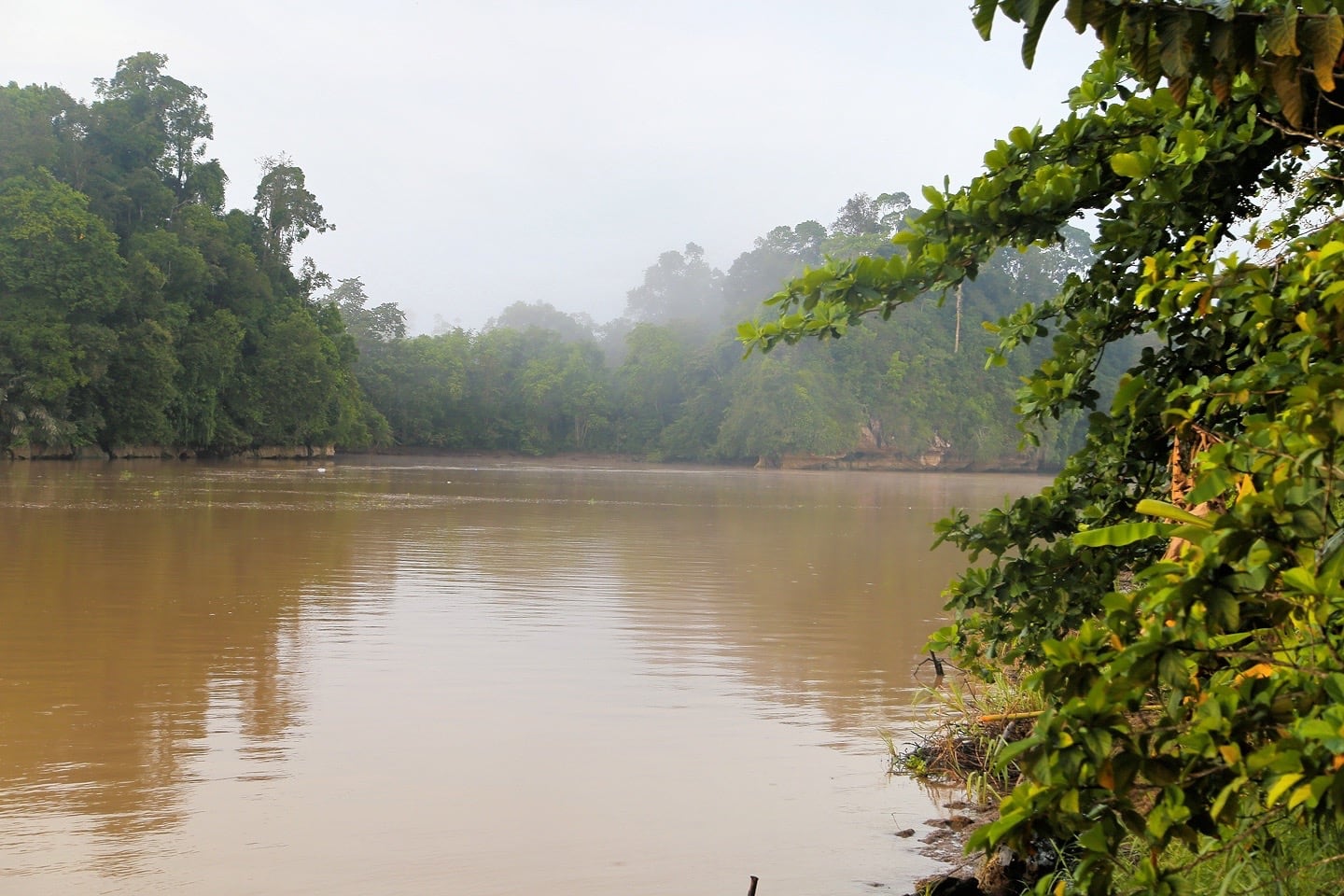
A thin layer of fog hung over the river, keeping things cool and peaceful. But the humidity fogged up my camera lens rendering it useless for the first hour of our two-hour trip.
The downside was I didn’t quite get the shots I was hoping for. The upside was that it allowed me to relax and enjoy the ride.
I did get a few usable shots with my new-fangled GoPro before my camera lens became usable again. The lens on those things is pretty wide, so no quality snaps of the saltwater crocodiles or other wildlife we spotted along the way.

The highlight of the morning boat ride was meandering through a narrow tributary that emptied out into a small lake.
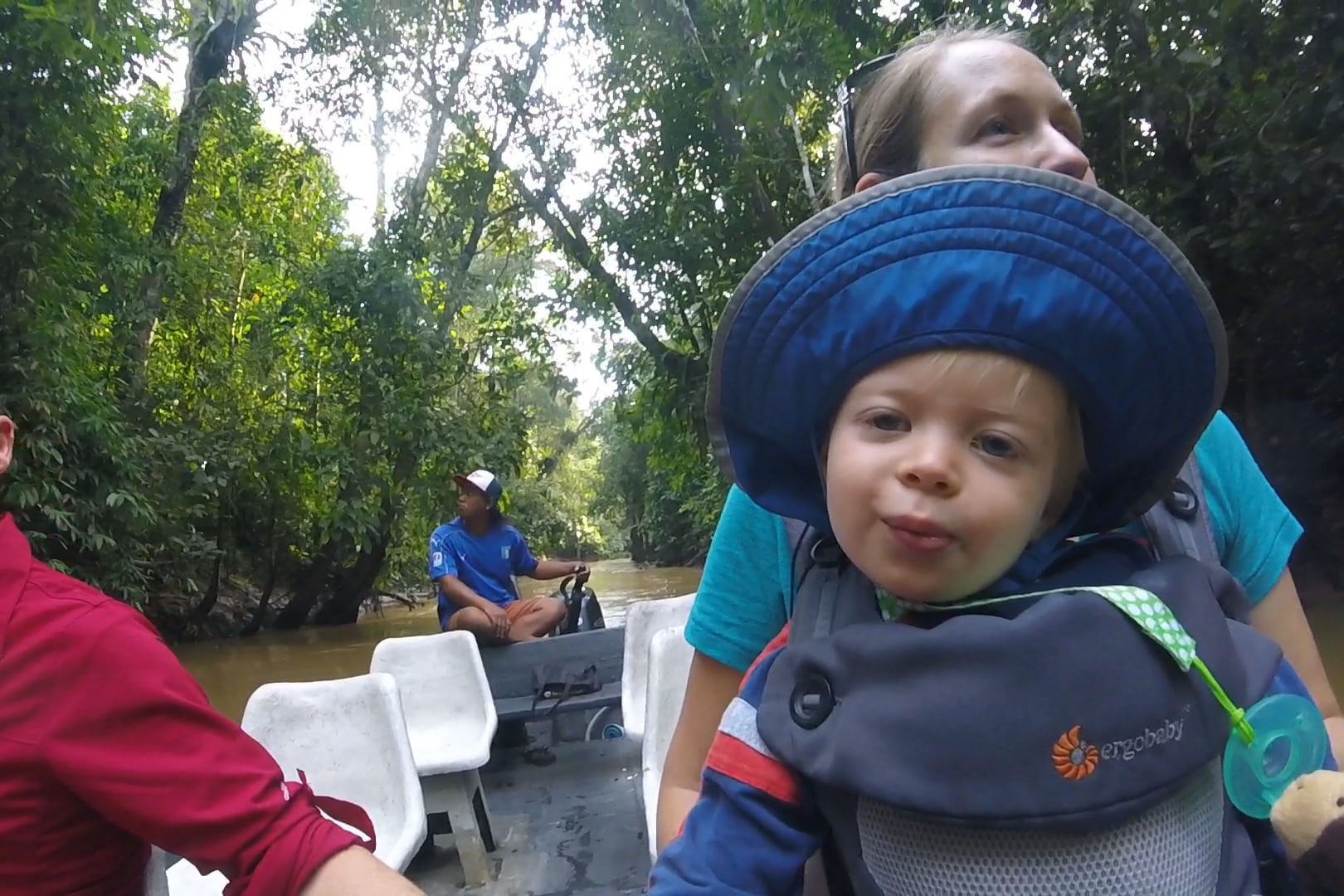
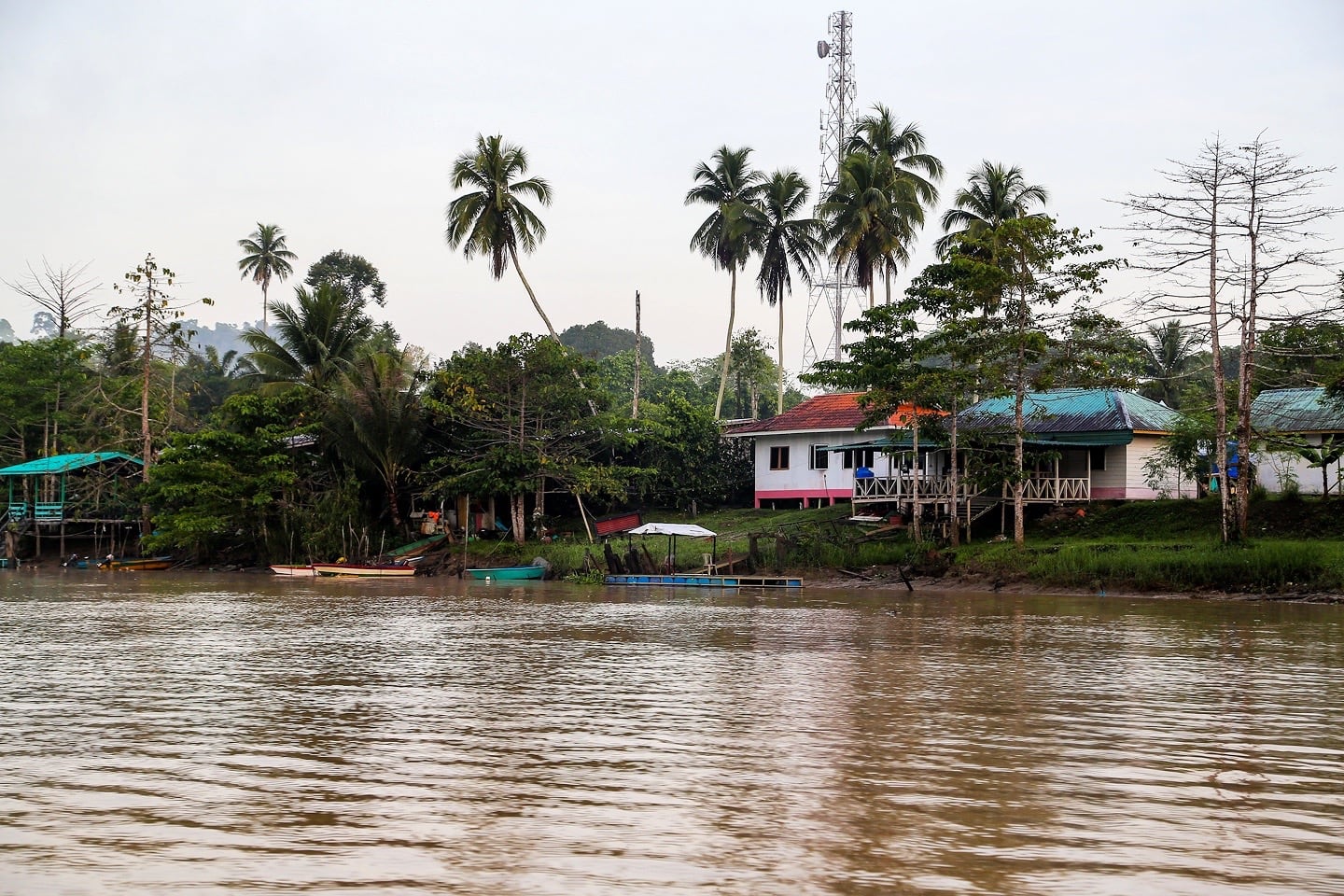
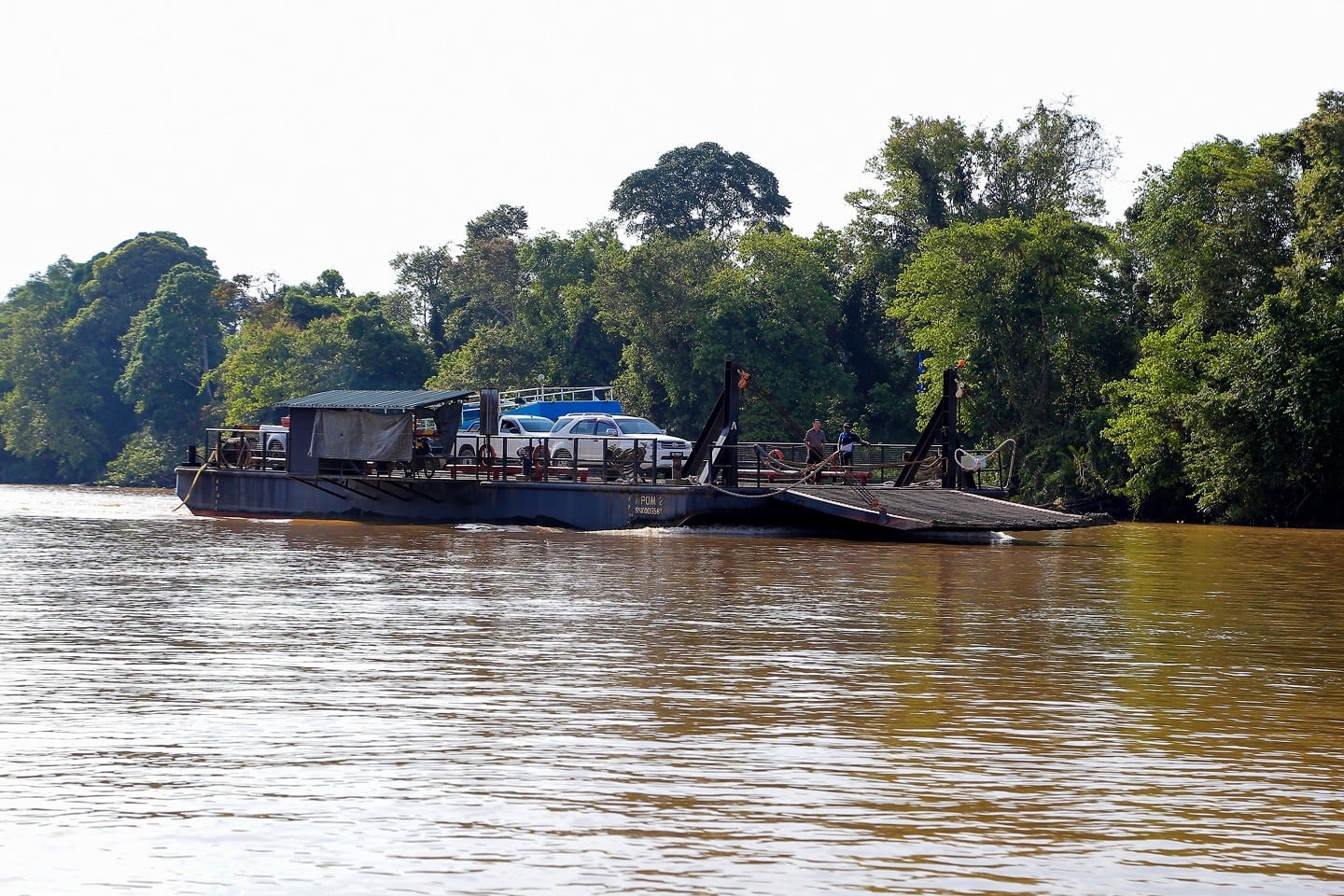
Next up, breakfast. Followed by a two-hour drive back up to Sandakan. We’ll catch a short flight this afternoon back to Kota Kinabalu, then another two-hour drive up to the final major stop of our Borneo trip: Three nights on a remote beach at an off-the-grid dive camp.
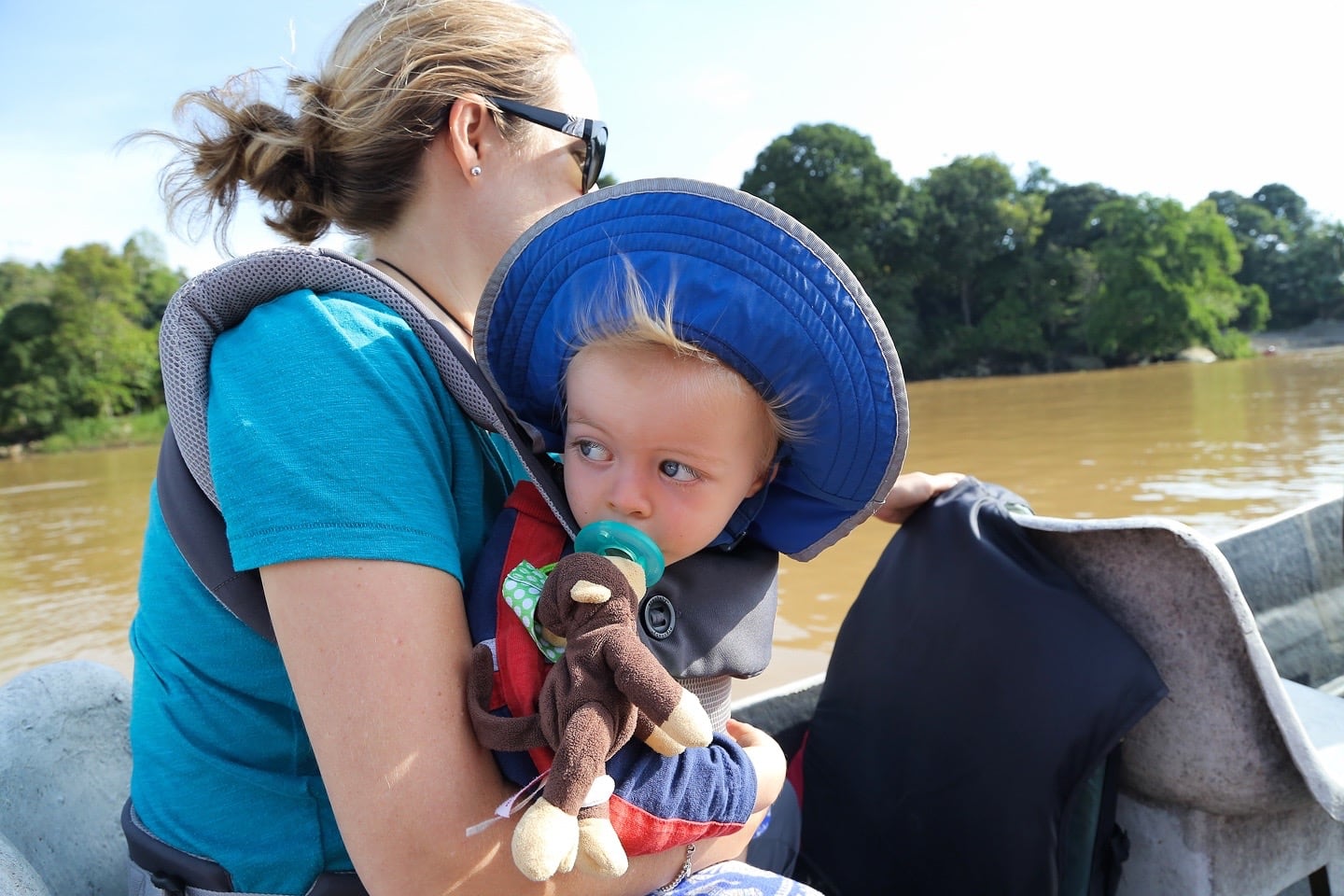
Our stay was perfect but for 2 things:
1) No Beer (only water, coffee, and soda)—this area has strong Muslim influence, which may have something to do with it. We’d read that you can buy beer elsewhere in the village and bring it back—no problems—but everything was closed by the time beer-thirty rolled around. In our backpacking days we would have brought a flask of the local spirit to fortify our sodas with, but with my drinking buddy out of commission for a while, I was just fine with sharing a Coke.
2) Guide no-show—our guide for the last day’s early morning boat cruise had some sort of last minute obligation and there was a miscommunication with the other guides, so we went with just the boat driver, which was okay, but not ideal. However, the lodge staff were responsive and apologetic about it and refunded us 30% of the a la carte cost of the cruise.
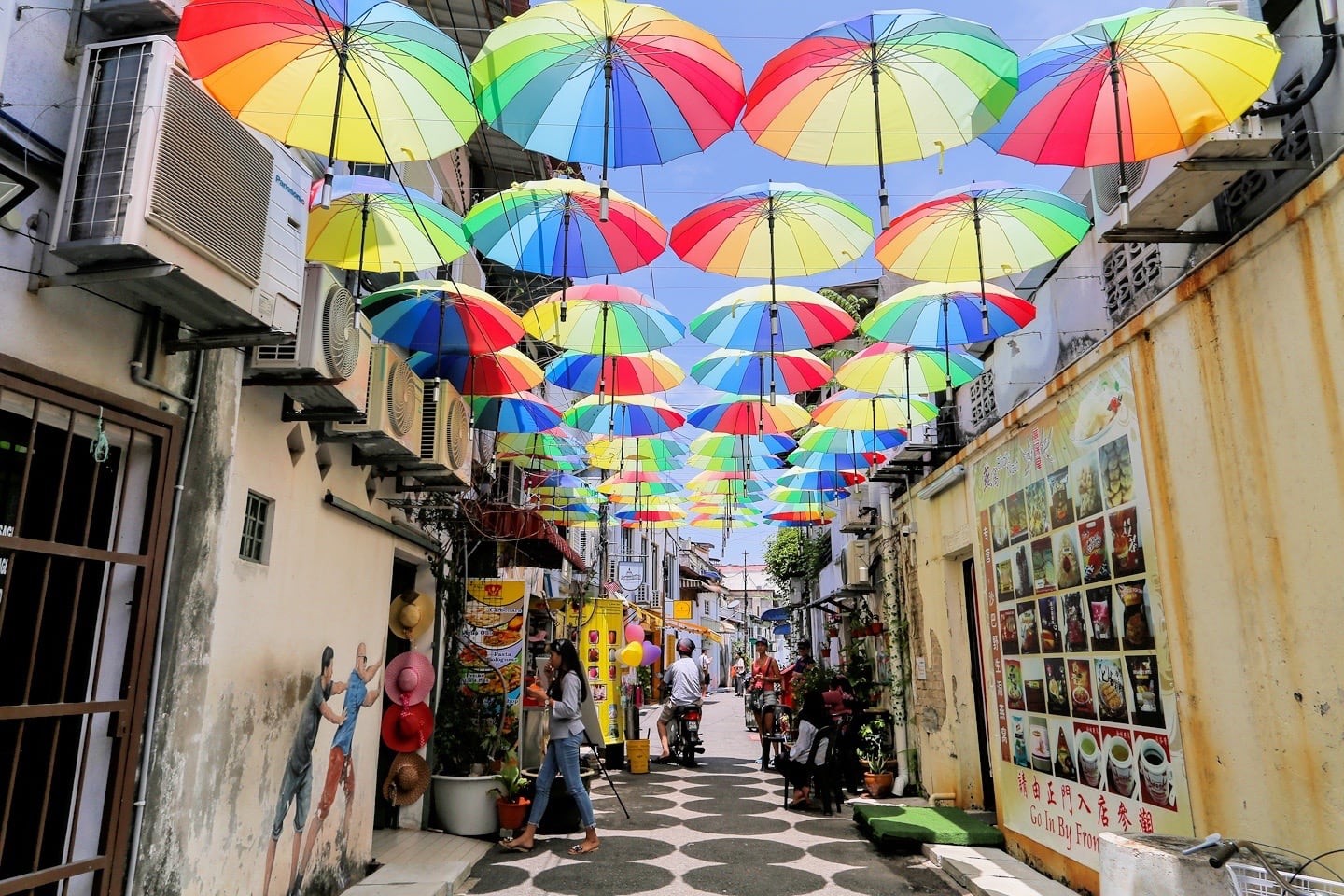
More Reading for Your Malaysia Trip
Around Kuala Lumpur
Penang Island
- Visiting Penang, Malaysia: Things to Do + Tips
- Penang Hill: Guide to George Town’s Great Escape
- Batu Ferringhi Beach: Why Visit + What to Expect
- Penang Street Art: George Town’s Colorful Side
- Visiting the Clan Jetties of Penang
- Visiting George Town, Penang: A First-Hand Guide
- Tropical Spice Garden & Tanjung Bungah on Penang
- Entopia by Penang Butterfly Farm: A First-Hand Guide
Borneo (Sabah)
Hi! I was on TFA w/ Lori and happen to have a little guy around the same age as yours. This blog is incredible travel-w-toddler inspiration. Thanks!
Awe, hi Kathleen–Thanks for following! Let’s meet up somewhere in this lovely world and let our little guys play together 😉
Can’t wait until your next post!
David isn’t making you wait too long these days! 🙂
Boats, wildlife, jungle–who could ask for more? Great photos!
All we needed was beer for David! 😉